#also its like 90 years old but developmentally i have NO idea
Explore tagged Tumblr posts
Text


Nemea's my pc for a Wild Beyond the Witchlight campaign I'm part of! (She/They/It)'s a nyxborn circle of stars druid who grew up in the Astral Sea, which made them. A little weird.
She also discovered that the hag who stole its sense of direction is fated to die under a solar eclipse, which is just delightfully appropriate.
#taith art#OC art#Nemea#dungeons and dragons#dnd#tabaxi#nemeas a weird lil' kitten#theyre gonna murder a bitch#also its like 90 years old but developmentally i have NO idea#nemea ages like a week in realspace per months at sea so.#thats math i am not interested in doing
13 notes
·
View notes
Text
I’ve Never Seen David Lynch and George Lucas in the Same Room at the Same Time…

The thematic parallels between David Lynch and George Lucas are something I keep coming back to again and again, but their careers and evolution have a lot of overlap too. They were born in the earliest Boomer cohort (George Lucas in May 1944, David Lynch January 1946) and had experiences growing up that were colored by the idyllic 1950s, but shifted into a distrust of authority structures that was common for many of their age cohort in the 1960s. They both came of age wanting to do something physical with her hands that felt creative to them in large grimy spaces - fixing cars for Lucas, and painting and installations with a fascination with organic materials, industrial metal, and rot for Lynch. They both fell into film because they were looking for something that satisfied their artistic bent (although film was never a primary aspect of her life to that point). They wound up making a handful of short films over a 3 year period, culminating in a longer short-film that would eventually get them noticed at roughly the same age (Electric Labyrinth THX 1138 4EB [1967] and the Grandmother [1970] for Lynch).
These films netted both of them a patron (Francis Ford Coppola for Lucas, the American Film Institute for Lynch) and started filming their first feature-length film two years after those films. They both got their biggest name recognition bump by films released in 1977 and pulled away from the power of the studio system in roughly 1984. Famously, Lucas offered Lynch a chance to direct what would become Return of the Jedi in about 1981 ( I prefer the story where Lucas does this by picking him up in a Lamborghini - I’ve heard a phone call version too, but it’s not as perfect) and Lynch answered something like “it’s your movie George, you direct it.” They both spent the mid 80s in movie jail, and although they took very different paths in general after (I’ve been emphasizing the similarities) there are still things that jibe in the history - they both reminded people of what they liked about them with a late 80s movie, spent a lot of the 90s on TV projects, did one project around classic radio, returned to theatrical notice around the millennium, all the while generally keeping their own council and disappointing a lot of fans.
There’s obviously a world of difference. Lucas is a left brained technologist who equated freedom with an owning of the means of production. Lynch is it right brained impressionist seeing freedom-as no one ever being able to tell you what to do, acting as a solo artist with collaborators who merge with his sensibilities. Lynch is a production lone wolf, depending mostly on people believing in him and funding him, and losing out in the popular consciousness by making uncompromising art that may not be what the audience wants, meaning funding is sometimes hard to come by. Lucas is like the Democratic party controlling the Congress and presidency - having total power but unable to turn that into what he really wants to make, somehow. The idea of Lynch selling his body of work to Disney is absurd.
But the correspondences in this are telling and help to explain the thematic similarities and divergences. Plus, the differences often relate to the similarities - Lucas identifies with corrupted controlling paternalistic power as a horror of inevitable capture of the individual by larger structures, while Lynch sees the corrupted masculine influence as an archetype, the call coming from inside the house, agency coopted by a collective taint in the universal pattern . But on some level these are the same thing - what is this person I am capable of becoming seeing as I am in control but yet not, doing horrific things? Lucas’ constant commentary on slavery is about hegemony and a systemic oppression he is complicit in, while Lynch has whole pantheons of beings that turn people into vessels that oblate the self and make them act on subconscious programming. Neither probably think the word neoliberalism too much but tend to communicate similar things about it is almost diametrically opposed ways.
The thematic similarities are rooted in a few areas that unpack in to a variety of subspaces which overlap – patriarchal structures as psychoanalytic dynamics (more Freudian father fixation for Lucas, Jung for Lynch), boomer generational failure as socio-first-but-economics-ultimately, the artist as in struggle with larger forces (largely of the self), and an eastern religious metaphysics that is American Christian in flavor. The major line of difference running through this is gender/sex/desire, Lynch being on main with a lot of spiritual overtones of sin, guilt, and “the fall” and Lucas finding this kind of guilt and sin as a secondary phenomenon that is mostly actively suppressed and unconvincing when it shows up; yet both wind up often finding physical consummation at direct odds with art in a gendered creation way (that also links Eraserhead to Age of Ultron and the original Frankenstein). Try doing a psychosexual reading of Howard the Duck sometime.
Lucas’ developmental through line is this: dude in love with 50’s culture but informed by 60s counterculture makes a movie where the young granola-ish revolutionaries win against the fascists in an effort to rewrite society but, having secured rights for “independent spirit” reasons now finds himself in control of something huge and immediately starts making art about boomer men becoming their controlling fathers and then moves on to movies where powerless freaks are the real focus. After a creatively fallow period, he comes back to make a sequel/prequel trilogy that is one of the most misunderstood complicated statements about people becoming what they hate as an eternal cycle at the level of the personal, the societal, the political, the spiritual, the artistic, you name it!
Lynch’s developmental through line is this: dude in love with 50’s culture but informed by 60s outsider/art counterculture makes a movie where the young artist struggles with the idea of a regular life, initiated by fatherhood, which attempts to destroy the artistic spark, after which he enters the Hollywood system and makes an artist as freak movie and a movie about plucky rebels conquering space authoritarianism (that the future of is books about that ending in messianic authoritarianism) and then disavows that system. He then proceeds to make art about subject and object as a supremely gendered thing, in a land that has fallen from grace, moving inexorably towards the idea of eternal cycle at the level of the personal, the societal, the political, the spiritual, you name it!
They both have an idea of the father-artist identified with the abject oppressed, under siege as figure, resentful from being kept from creation, over a career realizing that their “self” is the horrific villain of their own story. For Lynch, this is psychosexual, then spiritual, with a resisted toxic masculine urge to control and overwhelm, often in a violent way. It is the artist’s own urges that get in the way of making art, of desiring in the universe that has an unbalanced power structure from some far off echoes of an original symmetry breaking inherent to the archetypal gender dynamic. For Lucas, it is the realization that the artist in control has a tendency to become the controlling dad and sexual relations are inherently problematic in a political and spiritual way. Real art seems impossible if the artist has control, identifying with the downtrodden is a bit of a lie, happy endings can’t happen not because of the happiness bit because of the ending bit. For both, there is a fundamental flaw in the cycle, which is patriarchal in nature, but Lynch just approaches this much hornier.
The boomer part probably requires the most discussion, but the TLDR is that they are both are crawling out, through Vietnam, from the 50s social order, and grappling with how badly the 60s idealism failed. Lucas does this in the prequels as a big canvas critique of how the social revolution was co-opted by the generation not being able to see its own flaws, of not seeing the system taking over again, an Empire calling itself a Republic. An inability to look in the mirror and really see. The wisest oldest hippie is the only one who sees what’s happening, but is powerless as his apprentices are inevitably spit out, and the next generation has to be raised not by a skeptic but a true believer in “liberal” “democracy” (cynic quotes theirs).
Lynch is interesting here in that he most directly addresses this only in Twin Peaks, but we see more naked reflections, divorced of contemporary politics, in his other works. In Twin Peaks, Ben Horn is the Palpatine figure, who winds up a sweet old man buying off the harm his life’s work and progeny have produced while ignoring the poor and next generation personally. Jacoby the neutered, fried Yoda that eventually slides into Alex Jones territory (the canonical Boomer ethos in a nutshell – “what me” neoliberalism and change the world ideology going crackpot). All of Twin Peaks except for Fire Walk with Me is directly socioeconomically generational (Bobby Briggs becomes a young Republican in season 2, the mill, the trailer park), but the other works are full of class issues informed by Lynch’s age. From Blue Velvet’s suburban kid exploring his darker side by going to the poor part of town through a career of classist low-life encoding (Bob is a denim jacket wearing homeless person, all the covered in grime by the dumpster/trailer park characters, Ronette as the factory floor version of Laura, etc), culminating in Inland Empire and Twin Peaks the Return chronicling the fall of man as partially an (generationally specific in TP) economic fall into a unequal class defined world of needing an opening and leaving the house to labor as where evil is born. TP OS is about how boomers turned out just as bad, the Return is about how we inhabit the world of their ideological blindness.
All filmmakers seem to, at least to a certain degree, bring the question of creation of art directly into their work via distant or close metaphor. In Eraserhead and Elephant Man, Lynch values the spark of art which the downtrodden protagonist is trying not to lose. In Dune, the visionary with a big project that seeks to upend the system (but that we know eventually become something even worse) is a project that fell apart due to studio interference. Blue velvet is about the act of watching awakening something uncomfortable in us that is incompatible with normie life (it wouldn’t be weird to say it was about porn). Twin Peaks is about television, FWWM about movies, and all at least partially about closure being a death act in art. Lost Highway is about the artist tortured by desire, Mulholland Drive about desire being central to be eaten alive by the Hollywood system. Inland Empire is about filmmaking as a way into understanding the world on a deeper level (as is its unofficial sequel Inception) to cure its ills. All of this is art’s struggle against power, with an element of the major powers being subconscious forces that control us leading to desires that ablate the artistic impulse.
Lucas' projects have over time been about a young upstart independent filmmaker, losing his soul by becoming successful, and becoming the system, man. He then tries desperately to identify as really not the one in charge, until he admits to what he has become. He consistently dips back into filmmaking as an adventure or a good fight, but he has to set these in a time period before his birth. As in Lynch, having a child is equated with not being able to fulfill the kind of artistic destiny, but Lucas goes further in equating it to an excuse for why the powerful artist goes bad and needs redemption. He had a naïve or-is-it canny motif focused on the short inhuman outsider, often related to music or primitive settings (often with wooden cages) as a recurring thing for a while. These characters are often wise, or at least no filter tell-it, and are similar to the Elephant Man. This is a trope, sure, the wise different wavelength other, but there is also an identification of the artist at knowing and right yet impotent and a clue to the author’s metaphysical system.
Lynch is the mainline protestant in upbringing and very much influenced by a kind of proto-eastern religion (you can just say the Vedas for shorthand). Lucas is not very religious, but was brought up Christian, influenced by Christian symbolism and became interested in world religion as narrative via figures like Joseph Campbell. Hence, they both gravitate towards some kind of Gnostic Proto Christian, So-Cal zen, Thomas Aquinas “gets” Plato kind of amalgam, which informs their work. Lynch has veered towards an eternal cycle framework, and the very physics compatible idea of something in the past breaking and causing consciousness/suffering, through which we can achieve joy as a counter only through letting go of the self, and the recurrence of ruptures on all scales demonstrating a fractal pattern of hurt and redemption. Lucas also sees a big cycle, but it is one more of human existence as narrative that has a tendency to return, with a little bit of Nietzsche and movie eastern spirituality thrown in. Both believe in a recurring pattern that plays itself out in a way that is terrible, but hopeful, as the struggle is where hope derives from. Both have inherently Christian ideas and symbols in their work but lean back on non-Christian ideas that the Christian ideas have a history with. Lynch has his virgin Mary as the real Christ figure female angels that show up, while Lucas has turnt space Jesus.
Suffice it to say that the tree trial scene in the Empire Strikes Back and the lodge sequences in Twin Peaks are a very good place to start looking for how the two auteurs meet. Compare Anakin/Luke Skywalker to Mr C, look at the 90s turn they both made, register their seeing the “sleeper must awaken” of fiction being terribly fraught, compare the force vs. the universal field, the way their relationship status and partners carve their work into eras, and their continued existence as mainstream experimental filmmakers.
26 notes
·
View notes
Text
Our Favourite Albums of 2018

2012-2017 - Against All Logic
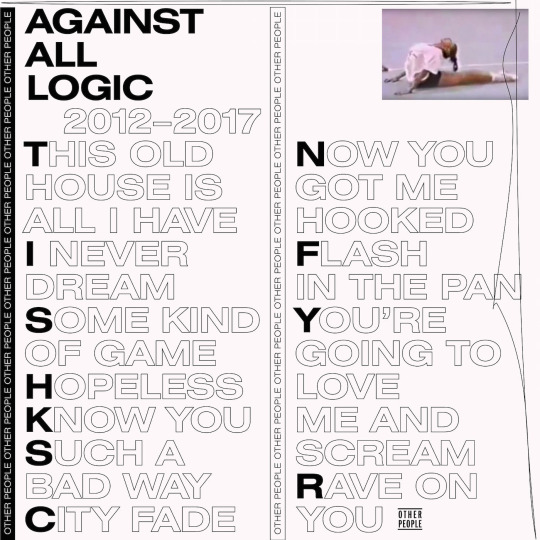
(Other People)
Whether Nicolas Jaar meant this to be an understated release or not, the deeply soulful samples, thunderous lo-fi aesthetic and immaculately timed and detailed track phasing of 2012-2017 make it one of the year’s most impressionistic and innovative electronic releases. Not pretending to be any more than a collection of house tracks, 2012-2017’s cohesion lies in its consistency of quality, as well as its lo-fi style. Jaar’s taste for extended, developmental dance songs is addictive and as fit for easy, danceable listening as it is for intense scrutiny. Every track begs repeated listens and rewards through revealing yet more hidden elements. It goes to show just how technically gifted Jaar is that an offhand collection of tracks can be so thoroughly excellent and make more of an impact than his more dedicated peers. -E
Dead Magic - Anna Von Hausswolff

(City Slang)
Dead Magic is Anna Von Hausswolff’s fourth full-length record in which she delves into the dark abyss in a purifying explosion of distressed emotion. A sinister ambience is maintained throughout, even during the more beautiful and uplifting moments – which are typically conveyed through Anna’s rich harmonies alongside powerful, yet unnerving, electronic drones. It is these moments that make Dark Magic what it is. Instead of wallowing in a pit of despair and desolation, Anna offers a way out, stressing that there is beauty even in the darkest of places. It is an exquisitely refined project which blends dark musical themes with emotive vocals to create a sonic soundscape that will leave you completely mesmerized. -M
7 - Beach House

(Sub Pop)
Simplicity has always been Beach House’s charm and on 7, not only do they manage to revert back to the gorgeous, organic simplicity of Teen Dream and Bloom, but they do so while immensely expanding the breadth of their sound. 7 is only fingertips away from the untouchable timelessness of those two aforementioned records, and is one of Victoria Legrand and Alex Scally’s most ambitious artistic leaps and successful reinventions. This is an affirming record, demonstrating the duo alive-and-well, working with a still-evolving sound; and as easily as capable of producing indie-pop hits (‘Lemon Glow’, ‘Drunk in L.A.’) as they are of thoughtful, tender ballads (‘Black Car’, ‘Last Ride’). 7 has its fair share of career highs, cementing Beach House’s reputation as one of the finest indie acts of this decade. -E
Twin Fantasy - Car Seat Headrest

(Matador)
Will Toledo is perhaps the most inventive, boundary-pushing artist in modern indie rock; so when he turned his hand to remaking his own 2012 Bandcamp release Twin Fantasy, the result was always going be interesting. With two ten-minute-plus songs, extensive spoken-word passages, and a distinctly self-aware tone, nothing of the charm of the original was forsaken. A hi-fi recording, reportedly utilising seven musicians and a hell of a lot of retrospective adjustment to the source material, 2018’s Twin Fantasy is everything you felt the original had the potential to be, and more. Instead of a messy, chaotic cacophony, here Toledo’s project is revealed as an intensely personal, momentous opera of indie rock, with Toledo as a proclamatory main protagonist, an idol of teenage angst and confusion. Twin Fantasy is epic and indulgent, flawed and truly excellent. Indie rock hasn’t seen anything as promising as Car Seat Headrest since its heyday in the 90s, and this band are still yet to disappoint. -E
You Won’t Get What You Want - Daughters

(Ipecac Recordings)
Bleak, harrowing and violent – three words that are often tossed around to describe bands loitering around the darker offshoots of noise rock; yet Daughters’ You Won’t Get What You Want accentuates those descriptors in their fullest definition. Like an atrocity one can’t seem to look away from, the Rhode Island band take the same uncompromising swathes of noise from their 2010 self-titled record but warp and extend it. Swallowing the rest is a manufactured, engrossing silence of negative space that underlies everything from the pulsating waves of distortion to Alexis S.F. Marshall’s vocals; from the clattering, dictatorial drumming to the smatterings of dramatic piano. Daughters’ thoroughly austere ethos has no release; You Won’t Get What You Want is uncompromising in its walls of thick, violent sound and thorough in its sheer immersivity. This is music unlike anything else released this year, and a revival statement for a genre that’s been largely stale for years. -E
Ordinary Corrupt Human Love - Deafheaven
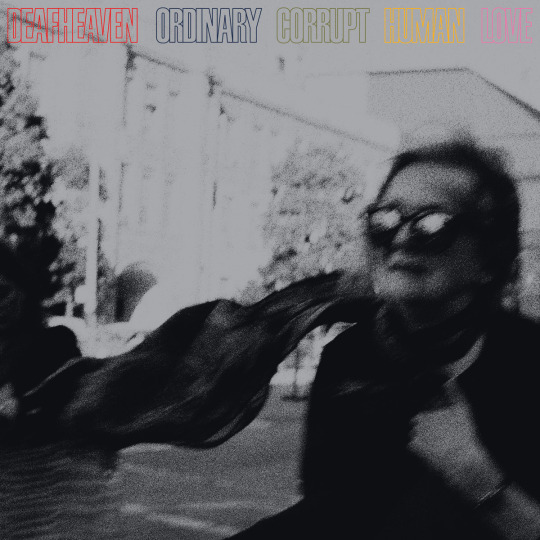
(-ANTI)
With their fourth release, Deafheaven give their critics the middle finger with an uncompromising statement of intent and self-determination. 2015’s New Bermuda hinted that the band had taken the critique of 2013’s Sunbather by metal purists to heart, as they went for a darker, more aggressive sound. With Human Love, however, we see Deafheaven position themselves in-between these two contrasting sounds, as they get the best of both. The hard-hitting aggression of tracks like ‘Honeycomb’ and ‘Yellow Canary’ will satisfy the most committed metal heads, whilst the hazy shoegaze of the shorter tracks, ‘Near’ and ‘Night People’, will enchant the Sunbather converts. As always, the juxtaposition of George Clarke’s piercing screeches paired with the beautifully aggressive guitar hooks of Kerry McCoy is something to behold. With the addition, this time of a heavily post-rock influence, the progression to an explosive climax has never been so poignant on a Deafheaven project. The LA outfit have switched up their sound flawlessly, finding the perfect balance of style and aggression in a masterwork of emotion and intensity. -M
Year of the Snitch - Death Grips
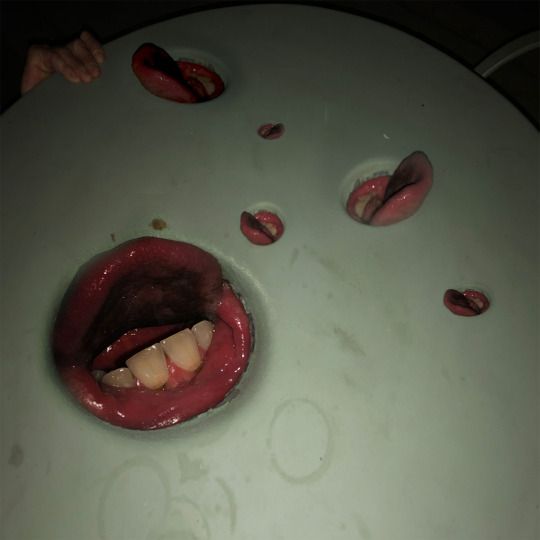
(Third Worlds)
How do they do it? This is Death Grips’ sixth studio album in as many years, and each one has been as exhilarating and unique as the next. Year of the Snitch is perhaps their most out-there project to date, and that’s saying something. This time out the trio go for a more experimental rock approach. The familiar elements of industrial hip-hop are of course still there, but they are dominated by heavy synths and guitar riffs to create a soundscape that is both unfamiliar, yet somehow typical of Death Grips. That, for me, is the beauty of Death Grips; no matter what direction they take their sound, they completely own it. Year of the Snitch is not going to dethrone Exmilitary or The Money Store, but it’s also not a runner up; it’s in a different world altogether. A typically unapologetic adventure through pop music from the Sacramento trio. -M
Knock Knock – DJ Koze
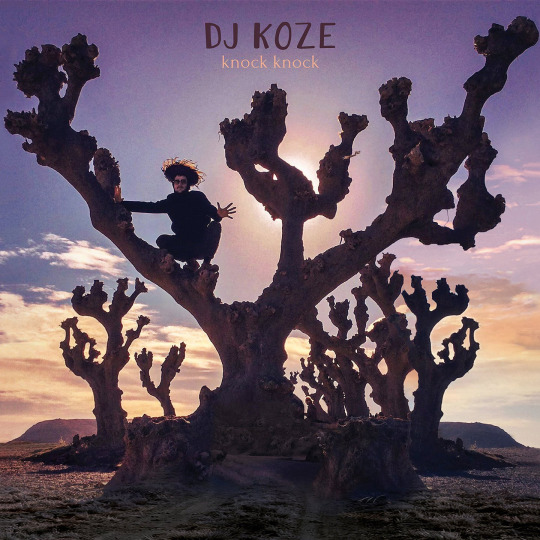
(Pampa Records)
knock knock is a house album that manages to escape the rather utilitarian nature of the genre, and is instead an artful and diverse project from the German. Koze is clearly a master of his class, as he effortlessly floats between hip-hop, soul, disco, house, and even folk, to create a project that is not merely a compilation of bangers, but a versatile playground of sounds, similar to that of [i]Wildflower[/i] by The Avalanches. The features on here are just as puzzling as the multitude of genres, with the likes of Bon Iver and Roison Murphey making appearences, but, of course, Koze manages to slot them in effortlessly. At 19 tracks, one would expect this album to feel like it had overstayed its welcome, but thanks to the wealth of ideas, it is a perfectly judged, captivating record. -M
Some Rap Songs – Earl Sweatshirt
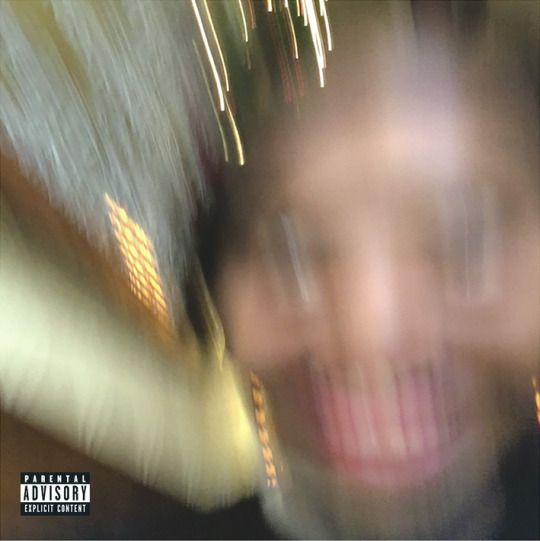
(Tan Cressida)
Earl’s transformation from the “hot and bothered astronaut” we were introduced to eight years ago, into the mature, yet despondent 24-year-old he is today has been and interesting and difficult experience to observe. His fourth full length album picks up where his latest EP, Solace, left off, as he continues to improve his craft, whilst simultaneously sees his mental health decline. Just like his earlier releases, the Madvilliany and Donuts influences are obvious, but this time take the form of production and song structure. Verses begin and end abruptly, choruses are essentially non-existant, and most of the beats consist of just a roughly looped sample. The result is that it feels as if we’re getting a peak into Earl’s musical sketchbook. Nothing feels finished or even polished, which gives the project a raw and intimate feel. Earl’s lyrics add to this feeling as he explores his state of mind by discussing his struggles with depression and the passing of his late father, displaying a maturity beyond his years. Some Rap Songs is a delicate and honest project from a talented and troubled artist, focused on the improvement of his art. -M
God’s Favorite Customer - Father John Misty

(Bella Union/Sub Pop)
Attuning his touch to more tender, less ironic pastures suits Josh Tillman to the tee. God’s Favorite Customer is a significant scaling-down from the grandeur of last year’s Pure Comedy, but the novelty of hearing Tillman’s actual emotions proves an adequate substitute. The metaphysical is, as always, a dominant, recurring theme, but the engrossing topics of failed relationships, suicidal thoughts and substance abuse combine for a stirring sort of listen that long-time listeners of his haven’t really had the opportunity to divulge in. As much as records need pacing, careers do too - whereas on I Love You, Honeybear and Pure Comedy Tillman is feeling sorry for us as a society and suffering with us along the way, God’s Favorite Customer sees him looking inward and finding a certain personal relatability. He’s a man who makes mistakes, and not so much the hip-swinging, foot-stomping unstoppable rock star he’s always seemed to be. Unmistakeably pitch-perfect vocals, supported by his usual excessively stellar songwriting and lush arrangements of horns, strings and so on, all make for yet another impeccable record from a man who can seemingly do no wrong. –E
Beyondless - Iceage

(Matador)
There’s a certain magnitude to the overall sound of Beyondless that takes your ears off; the culmination of four records of growth for Iceage from which they’ve emerged masterful, tasteful manipulators of their own terrifically refined chaos. The Danish art punk quartet edge closer to almost entirely orchestral noise rock (‘The Day the Music Dies), while also never straying too far from pop (‘Pain Killer’, ‘Catch It’). More a refinement of the style initiated on Plowing into the Fields of Love than its own bold stylistic turn, Beyondless reveals Iceage as a much-needed successor to the angrier days of the Bad Seeds. Gritty and throttling but eloquent too, their particular brand of post-punk isn’t just vastly noisy and technically excellent, but distinctive, promising and unlike anything else in the current scene. –E
Joy as an Act of Resistance - Idles

(Partisan)
Not one for the Tory snowflakes. Forty-odd minutes of Joe Talbot unrestrainedly slapping down the hypocrisy in the British right wing, taking pleasure in exposing the ridiculousness of all things bigoted, from Brexit to anti-immigrant sentiment, toxic masculinity to class hierarchy and general snobbery. It’s a piledriving critical punk commentary on Britain’s 2018, but more than just Brutalism updated for this year’s current affairs. Joy has some impressive musical developments, from more ambitious slow cuts like ‘Colossus’ to more emotional instrumentals, such as the heart-breaking ‘June’. Talbot isn’t the most subtle of political commentators but that’s precisely his point; and instrumentally Idles make sure every track is immaculately and brutishly performed, with nods to various strands of British punk dotted throughout. All the perks of Brutalism plus clear improvement, Joy is one of the finest punk records of the decade, from one of this year’s most essential bands. -E
POST- - Jeff Rosenstock
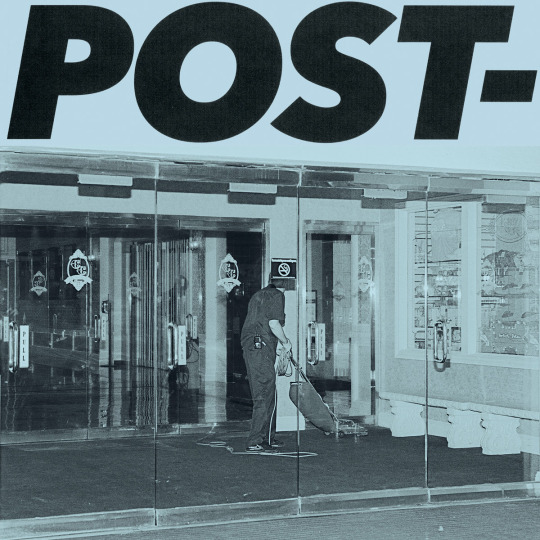
(Polyvinyl)
Jeff Rosenstock follows up his 2016 record, WORRY., with a similarly hostile and exhilarating showcase of pop-punk as it should be done. On POST-, Jeff’s dense style really shines through as the fierce melodic punk music is paired with cynical and somewhat depressing lyrics to create a perplexing, yet rousing juxtaposition. The lyrics are as catchy as they are striking, with many notable chants that will get stuck in your head for days. “ET TU USA, ET TU, ET TU USA!” It is unfortunate for Jeff that the success of WORRY. has somewhat degraded the standing of the record with most critics. POST- should not be overlooked as it is still an incredibly fun album, full of memorable chants and defiant sentiments. -M
Aviary – Julia Holter

(Domino)
With such a change of direction from her previous effort, Julia Holter’s fifth full length release, Aviary, rejects traditional pop song structures, and offers us a work of art which is as beautiful as it is mad. It is perhaps the most uncompromising album released this year, with no regard for its accessibility or its reach. There are four-minute bagpipe spectaculars, howling choral compositions and moments of arduous free jazz. It is, indeed, a difficult listen at times, but we are rewarded with moments of sheer beauty. This is exactly the point Julia wants to make. She wants to portray the mayhem and hysteria of modern life, describing Aviary as “the cacophony of the mind in a melting world”, but also gives us an important message of hope and the resolve to look for an answer. That is why this album is so important; it is a vessel for empathy that invites disparate people to join in her euphoria.-M
Kids See Ghosts - Kids See Ghosts

(G.O.O.D. Music/Def Jam)
Kids See Ghosts is a rare, rare breed of album that manages to take two artists and exact them both at the pinnacle of each of their abilities. Take Kanye West, at his most creatively unsettled, apparently cramming as many production ideas as he can into twenty-four minutes. Add Kid Cudi, and his apparently perfect range of singing, humming, harmonising and hook-crafting. Kids See Ghosts not only has them both at their creative peaks, but at their most lyrically relevant. West’s verses are incredible, eloquent and playful, reminding listeners exactly why he’s more than just a talented producer. He’s less confrontational and hubristic, while Cudi offers sensitive and deeply personal verses on his own journey through mental health problems. This is easily both artists’ best work this decade, an endlessly relistenable treasure-trove of a record that feels like more than just a genuine accomplishment, but justification that neither of these artists deserve any less reverence than they were deserving of in the first place. -E
I’m All Ears - Let’s Eat Grandma

(Transgressive Records)
British teenage duo Let’s Eat Grandma’s debut is enthralling, accomplished, experimental stuff. Channelling a broad range 80s synth pop idols such as Soft Cell and George Michael, but also taking obvious influences from modern pop artists like SOPHIE and The xx (not to mention Pink Floyd on ‘Calm and Collected’); Jenny Hollingworth and Rosa Walton’s ambitious songwriting, endearing lyrics and knack for poppy hooks aren’t just immaculately written and arranged, but make for some of 2018’s most addictive tracks. Virtually every track feeling like a single; the emotionally heavy ‘I Will Be Waiting’ or the jumpy ‘It’s Not Just Me’ are just as easily radio-friendly as the slow cut ‘Ava’, or the Oil Of Every Pearl’s Un-Insides run-off ‘Hot Pink’. Add to the mix the two long cuts, ‘Cool and Collected’ and ‘Donnie Darko’, and I’m All Ears gives a broad definition of the duo’s ambitions and talents, indicating their fondness for extended instrumental phases and ability for writing well-structured, impressively mature tracks. -E
Now Only - Mount Eerie
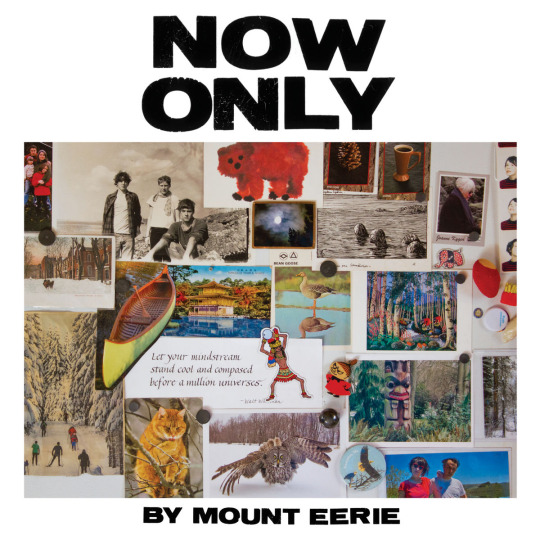
(P.W. Elverum and Sun)
Now Only, as a companion to last year’s A Crow Looked At Me, feels just as poignant a documentation of the process of one man’s grief as that record did. Slightly brighter and more reminiscent than purely devastated, Now Only shows improvements in Phil’s mental health not only through its themes and lyrics, but in how it expands instrumentally and structurally far beyond Crow, further toward the territory of the Mount Eerie work of old. Phil still has an unerring ability to chillingly plunge his listener back down to Earth with the utterance of a single, understated line, always having the reality of death looming over his vocals, no matter how wistful and optimistic they may seem. Phil can (like Kozelek, Malkmus, and few others before him) sing regardless of rhyme or pace, transcending lines and effortlessly fitting instrumental structures that occasionally err towards his work on Wind’s Poem or Clear Moon. Now Only is anything but another A Crow Looked At Me, an intense, documentary listen that demonstrates musical recovery as a metaphor for personal progress, that will (along with its companion live album, After) surely go down as one of the most profound artistic commentaries on death in popular music. -E
All Melody – Nils Frahm
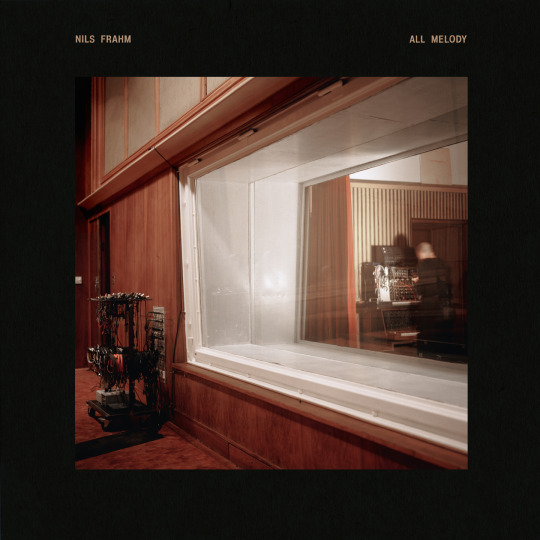
(Erased Tapes)
Nils Frahm’s All Melody is a real masterclass in progressive electronica. Following the atmospheric opener, ‘Sunson’ really kicks things off; a nine-minute rhythm-driven epic, with the pulsating hits of the bass marimba intertwined with pan-flutes and delicate synth melodies. From here we get an assortment of climactic electronic tracks, intense choral compositions and beautiful piano pieces, which somehow manages to maintain an impressive sense of cohesion and flow despite the disparities of sound. All Melody remains calm and meditative throughout, with a melancholic mood, but you never lose interest; each track is as captivating as the next. The attention to detail and texture, really make this album what it is; the nuances and subtleties give it the depth that an album with such ambition needs to stay interesting and emotionally compelling. A remarkably well rounded and unique album, incorporating qualities of techno, ambient and classical music to a devastating effect. -M
Wide Awaaaake! – Parquet Courts
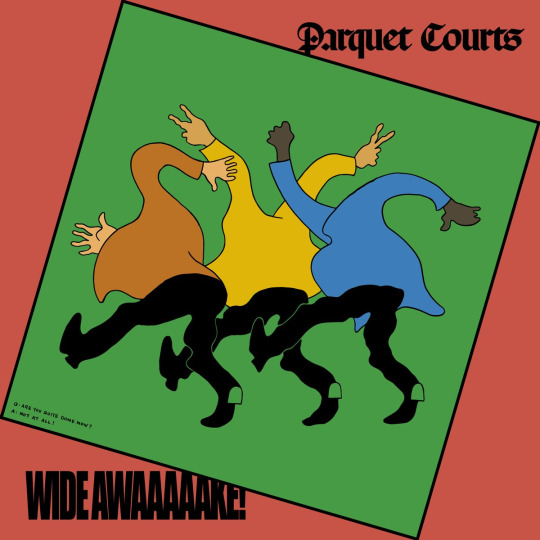
(Rough Trade)
Wide Awaaaaake! is a fantastic leap forward for Parquet Courts. The record is produced by Danger Mouse, a match that doesn’t necessarily make much sense on paper. However, the Grammy award winning producer allows Parquet Courts to run free, only adding his signature touches when completely appropriate. The result is that Wide Awaaaaake! is the groups most diverse record to date, with a wonderful sonic range from aggressive indie-punk to afro-groves reminiscent of Remain in Light. And the songwriting on this record is amazing. Savage and Brown hit gold with a dynamic blend of their classic art-punk rages and a more contemporary commentary. These lyrics are politically charged and socially conscious, yet done with such taste and style that nearly all pretension is avoided. Wide Awaaaaake! is a success on all accounts; Parquet Courts have experimented with their sound just enough to create something that sounds familiar but also entirely different. -M
DAYTONA – Pusha T

(G.O.O.D Music)
I think we’ve all been waiting for this for a very long time. Since Clipse broke up in 2010 and Pusha T started his solo career, there have been glimpses of brilliance, but his full-length projects have never truly delivered. Daytona, however is the perfect mix of his cocaine kingpin persona, political art rap, and gritty, challenging beats. All of these factors are typical of a Pusha project, but, under the direction of Kanye, there is a real sense of cohesion and focus which has been missing throughout Pusha’s solo career. The ending, Infrared is a particular highlight, as Pusha addresses the unscrupulous history of mainstream hip-hop, whilst also cementing his integrity within the genre; he truly is the ‘rapper’s rapper’. At a mere 21 minutes, this album will be one of the shortest in terms of run time you will hear all year, but it makes for an airtight listen, with no fillers – just straight bangers. -M
Compro – Skee Mask

(Ilian Tape)
On Compro, Skee Mask takes us on a trancelike adventure into the heart of the arctic tundra and out the other side. The opener ‘Cerroverb’ sets the scene as reversed samples are paired alongside occasional bass flickers to create a cold, dreamy atmosphere. From here on in there is a subtle exploration through 90’s dance music, with influences including trip-hop, jungle, and everything in between. Through his keen ear for a melody, and ability to bring his drums to life, Skee Mask reminds us how devastatingly sensual the fundamentals of dance music can be. Compro is a masterwork of simplicity and perfectly timed progression. The subtle changes to the texture and the slow build-up of the breakbeats throughout results in a vastly nuanced record capable of mixing these cold ambient scores with the energetic breaks and techno beats. -M
Oil of Every Pearl’s Un-Insides - SOPHIE

(MSMSMSM/Future Classic/Transgressive)
SOPHIE’s full length debut is as beautiful, beguiling and absurd as expected. Humorous and sincerely insane, Oil of Every Pearl’s Un-Insides ranges from achingly, tentatively soft to thunderously, tectonically loud, from dystopic drone to tongue-in-cheek BDSM references. It’s extravagant and knows it, and we wouldn’t have expected any less from the debut of one of contemporary electronic music’s most promising and revolutionary pioneers. Everything about Oil of Every Pearl’s Un-Insides is postmodern and glorious, displaying an excellence down both ends of the intensity spectrum; from the enveloping atmosphere of opener ‘It’s Okay to Cry’ to bombacity of EDM banger ‘Immaterial’. It feels exploratory of the capabilities of electronic music, seemingly including a take on Top40 pop, glitch, ambient and many, many other styles. A deliberately confusing listen, this is easily one of the most interesting albums of the year and one that I hope becomes a blueprint for others to copy in the years to come. –E
Superorganism - Superorganism
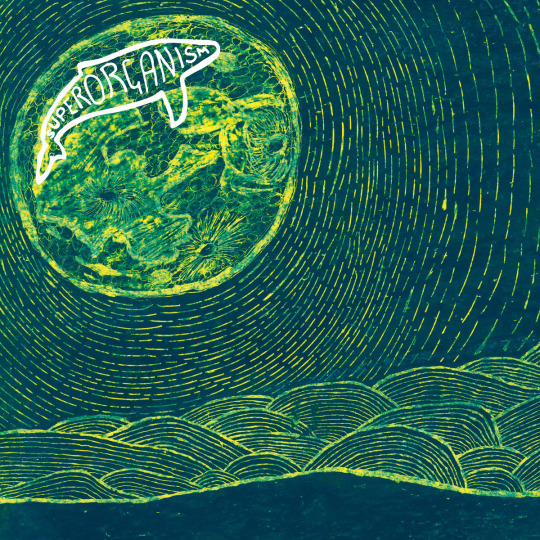
(Domino)
No one quite knows exactly what a “Superorganism” is (in musical terms), but if it’s some kind of eclectic creature churning out broad, slightly-left field and all-fun pop tracks, then this London-based, multi-continental eight-piece bedroom-pop collective fit the description pretty well. Don’t think too much when listening to Superorganism and it’s a joyous and bouncy, accessible indie pop album brimming with catchy choruses and ear-worming melodies. Listen deeper, and it’s jumpy and rich, glitchy and noisy; laden with quirky “found-sounds” like car horns and screeches, and playfully complex and layered. Playful, fresh and fun, the octet’s debut proves that mainstream pop doesn’t have to be mundane and formulaic, and that there’s a potential future in interesting, inventive pop music. -E
Konoyo – Tim Hecker

(Kranky)
Following the somewhat disappointing Love Streams, Tim Hecker is back on top, as he turns to Japan for inspiration – in particular the ancient courtly music known as [i]gagaku[/i]. The archetypal flutes, drums and strings of this traditional genre are contorted and manipulated, and eventually swept away into the cold and eerie electronic drones typical of Tim’s previous work. What emerges are vast soundscapes that are both minimal and monumental. Tim knows exactly what he is going for and is in complete control, able to fuse points of extreme simplicity and intense noise together so seamlessly. Konoyo is one of the most immersive listening experience you will have all year, and certainly puts itself forward as contender for ambient album of the decade. -M
Cocoa Sugar - Young Fathers
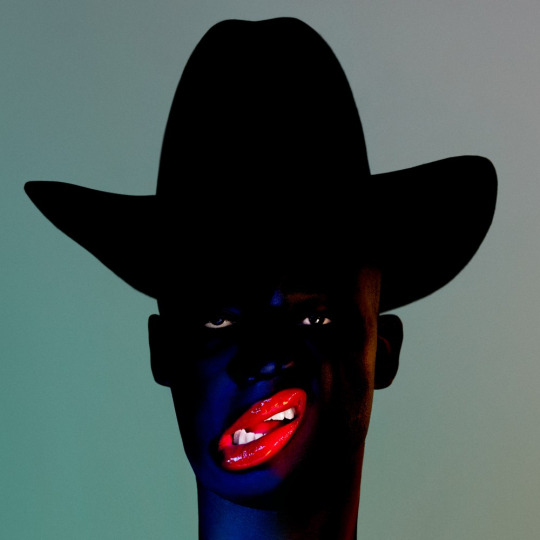
(Ninja Tune)
There aren’t many sounds in modern R’n’B as soothing as the three Scottish voices of Young Fathers, pining in tandem with their signature hypnotic, larger-than-life harmonies. Cocoa Sugar brings together the trio’s expansive, hymnal vocals and impassioned performances over instrumentals constructed of bass-heavy beats and minimalist melodic injections; crafting dense tunes with emotional weight and political potency. There’s an ardent politicism running throughout tracks like ‘In My View’, ‘Toy’ and ‘Border Girl’, as well as an undeniably British perspective that makes Cocoa Sugar relatable, relevant and important. On top of all that, it’s also impressively experimental; Young Fathers’ freedom from traditional song structures, accompanied by their distinctively alternative beat style, feels abstract and purposeful and unlike anyone else. This is their finest release yet, a brilliant demonstration of their stylistic breadth as well as their ability to work politics into their very particular niche of R’n’B. -E
2 notes
·
View notes
Text
Would Americans buy a Chinese car?
From my view, yes. Here’s why a Chinese car might stick around long enough to catch on with American buyers.
Cars are pillars of status, privilege, and pride in the USA. The car has truly made its home in our country and to many we often see them as members of the family or a faithful friend. Some like to show off with luxury or sport models or brands to denote their position in their company, neighborhood, or for the thrill of driving something fun or special. Most of us own what I would refer to as a daily driver, a car that gets you to A and B without fuss with creature comforts that make the everyday drive possible and while adding buckets of practically for any adventure. Some own minivans or CUVs/SUVs for hauling stuff around easier or to move large families around with oodles of space. Trucks are great for even bigger hauling and towing things around like boats or trailers of beer or stolen copper wire. However there is a price to pay with all this, depending on brand or model, new or used. Buying a vehicle is quite the important purchase for many. And they aren’t cheap depending on entirely what you’re looking for. And this is where the Chinese auto manufacturers might have a leg on nearly all brands currently selling in the US. This even includes the value leaders of Kia and Hyundai, who have been known to sell cars at more reasonable prices than their competitors and offer more for what you’re buying.
Installing a brand into a new market isn’t easy, however we have seen a template in which new guests into the US auto arena have done very well to get anchored in and to weather to storm ahead. At first European brands immediately after WWII have established themselves and have secured a foothold in the US, so did the Japanese in the mid 1960’s and early 1970’s, the Koreans in the late 80’s and early 90’s, and even late newcomers back on American soil like Tesla in the 2010’s have found their way to be taken seriously on the big stage. That successful template is offer something special or affordable in value, or do both. The original Volkswagen Beetle offered affordability, simplicity, and economy that was hard to pass up in the car starved post war era of the late 40’s. So was the Toyota Corona and Corolla of the late 60’s. The Koreans offered the Hyundai Excel that also provided much the same qualities. At the time when they were new, they were “the” disposable car of their time. They did a job well and adequately without many frills, and they were good value for the money for their respected time periods. Even the little Yugo from Socialist Yugoslavia offered the cheapest car in the US that only did the job to get you around town that didn’t get you wet when it rained. They offered both young people and adults who didn’t have a lot of money to spend or who wanted to buy a new car at second hand car prices, cheap affordable wheels they can take home with.
Now it’s 2018, and the brands that introduced themselves humbly during their times are now well established with the American buying public. No longer do we look at brands like Toyota, Honda, or Nissan with skeptical views of cheapness or being unpatriotic of not buying domestic, even today the scrutiny of buying Kia and Hyundai products is nearly nonexistent in our day and age because they have continued to up their quality and value game. Much like the many imports before them, we see them no differently than how we see GM, FoCoMo, and Chrysler-Fiat products. Just another quality brand. However now, there is a catch that we now see today, the import brands that came into our country that once touted affordability have now slowly over the passage of time become a tad out of reach for younger buyers. Yes cars are expensive, but most cars you see on dealer lots tend to be more expensive mid and upper trim option levels for most models, and you have to do some digging around to find a new car that is cheap enough to fit within budget needs. And here’s why this affordability is important with the feasibility of seeing Chinese cars in the US market. The average age of a car in the US is 11 years old, which honestly doesn’t sound that bad, though that feels kinda low. I’d feel it’s more like 15 years old, there are still a ton of older cars still rolling about the hills and the back roads. But whatever it is, people are holding on to them for many reasons. Can’t afford a newer car, maybe with plenty of work done a car could be driven for a lot longer, or maybe life priorities don’t call for the purchase of a newer car.
Now let’s take a look at the Chinese auto industry. The Chinese economy is very much a living example of the Yugoslavian hybrid model of “market socialism”, centralized planning with capitalist competitiveness coexisting well together that promotes more frequent updates or advancements with the goal to sell to the consumer without having industrial or economic waste. Other socialist states didn’t work like this, and how they had vehicle development, marketing, and production was a much more different animal than what is seen in China today. And because of this, China’s automotive industry is has blossomed into many companies producing many models of vehicles for its vast “captive” and export markets. Some companies have properly obtained licensing agreements and their technical packages to produce vehicles, while some others have reverse engineered vehicles to blatantly copy. Their quality ranges from comparable to Western cars we come to expect to just low quality junk that we haven’t seen in cars since the 80’s or 90’s.
If China makes most of our consumer products, cameras, phones, selfie sticks, appliances, industrial equipment and car parts, why not whole cars. Well China did try to extend into our auto market by selling us the Coda electric sedan on the West coast for only a model year from 2012 to 2013, and selling a dismal 117 units. Quality wasn’t where it should have been for the cost of $40k, and initially scheduled to be launched back in 2010 was held back two years due to lack of developmental time for durability. For the first US market launch of a Chinese made car that designed in 2004 on an older Mitsubishi platform, and an electric car right off the bat, no bite and little positive impression.
Now for real, let’s say China markets a car brand for the US that passes Federal Motor Vehicle Safety Standards (FMVSS) and fuel economy/emissions standards, they should start with basic affordable cars that people want to buy. It’s a no brainer that the US market for car sales is a huge market on its own, and even other European companies are envisioning a return back to grab a small slice of the market pie. For one, Americans might draw some skepticism to a Chinese car but the idea of buying a compact or even midsized sedan with loads of options for less than $15-20k is a tantalizing prospect and would buy them up like they did the Yugo. The Yugo did alright for staying in the market from 1985 to 1992, selling 142k units. If you can sell ten thousand cars like how Scion began in 2003, you’ll make a good enough foothold in the market, unless you’re Daihatsu. Sorry Daihatsu, maybe a subject for another day.
What are you going to expect with your Chinese car when you get it. I would expect body panels that don’t align well as they should have, “orange peel” paint finish, interior plastics that look like they won’t last long, sheet metal that might go rusty in a couple years, seat fabric that might rip in not much time, fit and finish overall is generally an afterthought. Again, you’re paying to get pissed off like buying a $3990 Yugo sold new in 1986 (if you could ever find one that sold for that low back then), but remember that you’re buying a set of wheels that’ll get you by for the time being. Much like how people expected Hyundai Excels to be just garbage piles, still preformed the duty of a basic if not agricultural car. But that would be a worst expectation of what a Chinese car could be. Who knows, maybe if the Chinese are that serious about the US market, they’ll build a separate assembly line like the Zastava factory who built the Yugo for the USDM. Here’s a scary thought, we all know how much of a mixed bag the Yugo was in the US, and to think the ones that made it here were built better on another assembly line meant for our market, I can’t imagine what the Yugoslavian market Yugos were like.
Much like every cheap and affordable car that introduces itself to our market, expect it to have little to no resale value to speak of, however you’re not really expecting to sell this car if you were looking at buying one. In your situation, you’re buying your first car for the first time or needing a second car, something to get you rolling for the time being. Whether if you’re in college or in highschool, or down on your luck with an older car that kept falling apart. The idea that you could buy a Chinese car for peanuts is something that’ll get the job done, and not care much about what you’re driving. You’re not expecting mind bending performance or luxury, you know what you’re getting into if you do, and the more you accept this the better. I mean no Toyota Corolla was ever sporty in the 70’s, it was the car you bought after the Ford Falcon finally rusted away and you needed to buy something fast so you can still go to night class. And if there were Chinese cars in the market here to buy, I’d buy one to drive it into the ground to either save up for a better car or just to buy another if one wasn’t enough. In the world of millennials sometimes having no credit or shit credit could transpire into a hairy situation of sticking with a rusty 90’s Nissan Sentra affectionately named “Liam Nissan” that eats too much oil or asking your aunt to buy her equally rusty Plymouth Breeze with empty cigarette packs scattered around. You’d rather buy a Chevy Cruze however you’re afraid that one for $10k and 83K miles might end up needing routine maintenance that you couldn’t afford to pull off on the spot and any new Kia Rio found on a dealer lot is still thousands over the mythical minimum sticker price. Hell, if a Chinese car was too expensive brand new, wait a year and you could even get one for sub $6-8k prices, maybe even less.
Honestly I’m really surprised that the Chinese haven’t entered our market yet, they have entered the European zone and been a huge mainstay in Russia (I guess Ladas aren’t cheap enough for them) for years now. They can range from cheap to really adequate modes of transportation, even something to own for more than you really require of it. The Chinese have been making Audi’s, BMW’s, and Buick’s with huge demands because they have been grand sellers in terms of luxury, and they tend to be of quality similar to their genuine originals. Whatever the Chinese do throw out us someday, we’ll gladly be in open arms for cheaper alternatives to newer, or really used cars. Plus, we Americans love to rip on unknown shitboxes, then in 15 years’ time we are buying them by the thousands. Who would guess in 1966 that Toyota would be producing quality luxury sporty cars under the Lexus brand. In 1995 when Kia would one day be producing a car like the Stinger that is chasing around other RWD sport sedans. In 1992 the Yugo going on to better things….oh wait we ran out of Yugoslavia by then. Mhmmmm we never really did get the Tata Nano here in the states (who remembered when that came out, $3000 car that had a fire problem), even though that there was an interest for a short while. In 1970 Americans wouldn’t expect Datsuns to be called “Datsun by Nissan” in 1984 and just Nissan by 1985. Import brands change and morph in the fluid of time, and many are still here. I wouldn’t be surprised if a Chinese brand turns out to be a good seller in 5-10 years time much like how the other imports started out.
And apparently on a quick google search, it seems that the Chinese auto company GAC has an interest in joining the US market in late 2019. Under the local Chinese brand name….Trumpchi. They are serious, and honestly their vehicles don’t look that bad either. In fact they would fit right in with this country. They are figuring out a newer name to use in North America. No one is certain how reliable a new Chinese car will be in the states, but if it’s cheap don’t expect it to last forever.
If you made it this far, hurray! If you like my rambling, you’d like what I’d have in store in the future. If you don’t, well, I’m still going to write it down anyways. :D
Keep zooming!
1 note
·
View note
Text
OH RIGHT
I enjoyed a lot of podcasts this year
1. The Bugle
The joy of the Bugle this year was discovering who did and didn’t work in the rotating cohost spot; happily I feel like the best of the new folks are significantly better at the job of managing/coping with a pun-based satirical podcast led by Your Wacky Dad than John Oliver was, and also happily made my podcast feed less straight, white, and male, which is sorely needed at this point. The stories Anuvab Pal brings in from India alone make him a strong MVP candidate. (I think he’s also the best pure comic they have.) In the end though I have to give the nod to Alice Fraser, who does what nobody else can: she’s capable of breaking Zaltzman’s momentum. It’s a thing of beauty that this invulnerably pointless man has met his match in an extremely rude Australian woman who will happily match him pun for pun.
2. Crime In Sports
This is a true crime podcast where two basic white dude comedians you’ve never heard of tell the life stories of professional athletes who end up in jail - stories which inevitably bring up issues of race, class and mental illness - and I will tell you that they do okay with that stuff, not perfect, but okay, and that exceeded my expectations to the point where I ended up listening to enough of it to start to care about these mooks and their in-jokes and their running gags, and again, I seem to have a soft spot for dumb guys who are doing their best, and I probably got more laughs out of this thing than any other podcast I listened to this year. Your mileage will probably vary.
3. Nancy
WNYC’s Gay Podcast, hosted by two Asian urban millennials who in their cohosting rapport demonstrate and embody WLW/MLM solidarity at all times. It’s exactingly correct about things and is what I listen to after Crime in Sports to detox. It’s also pretty good journalism, if you’re a fan of/can stomach the studiedly casual bespectacled “umm”-ing modern NPR vibe which has become de rigeur with this kind of thing. The episode where a younger butch woman finds the older butch woman who gave her her “ring of keys” moment and tells her what she meant to her will make your heart explode.
4. The Adam Buxton Podcast
OK, Zaltzman isn’t really your wacky dad - he’s more your weird uncle. Adam Buxton is absolutely 100% your wacky dad, and he’s trying his best. He’s the middle aged guy who asks dumb questions about race and gender because he genuinely wants to understand - the aging hipster who took being right on for granted and is gamely trying to keep up as the world shifts around him. He’s kind of like Marc Maron in that respect, and in a number of others; the podcast follows the same basic format as WTF, and Buxton is the same kind of insecure overcompensating former cool kid that Maron is, except replace the aggression and Jewish neurosis with the deeply repressed performative childishness of an English public schoolboy. Reading back I have failed entirely to make this seem enticing, so let me highlight the bit of this that works; Buxton starts every podcast with a walk through the countryside with his dog, who he talks to sometimes. Buxton is cozy. If you like the Maron idea but don’t like all the personal abrasiveness, this one may be for you.
5. Killing the Town with Storm and Cyrus
To explain this podcast I am going to have to tell you a story.
The first thing that you have to know is that Calgary is generally considered to be the capital of Canadian professional wrestling, because the Hart family is from there, and Bret Hart is the most famous Canadian wrestler of all time. But: earlier this year a tweet made its way around wrestling social media suggesting that Winnipeg should actually be considered the wrestling heart of Canada, because while Calgary might have given us Bret and Owen and Lance Storm, Winnipeg gave us Chris Jericho, Kenny Omega and Cyrus.
To which even hardcore wrestling fans might reply: who the hell is Cyrus?
It turns out that Don “Cyrus” Callis, AKA the Jackyl, was a) responsible for the tweet and b) a complete nobody who was on TV for a cup of coffee in the late 90s and hadn’t been seen since. The closest he came to mainstream success was as the manager of a justly-forgotten WWF heel faction called the Truth Commission, a group of pro-Apartheid afrikaaner militiamen. (1996 was a very, very bad year for professional wrestling.) He almost became the manager of a group called the Acolytes, who were at least kind of a big deal during the attitude era, but after his first TV appearance with them (in which he got on the mic and shouted “VIOLENCE TURNS ME ON”) he was fired. He bounced around ECW and TNA and that was it.
Cyrus had also just started a podcast with Lance Storm, on which he claimed to the best talker the business had ever seen, among other things. It became clear to listeners that while he may not ever have caught the brass ring, he was a wrestler to his core - i.e., a bullshit artist, a carny and a fraud - and that he had paid his dues working shit matches in the middle of nowhere Canada when he was a kid, and was now happy to spend a seedy retirement bullshitting with his friend Lance and pretending to be a forgotten legend.
Except things kept happening for Cyrus. Piggybacking on that tweet and the imaginary Calgary/Winnipeg feud, he became a public champion of Kenny Omega, the hottest name in pro wresting outside of WWE, and a man who didn’t have a lot of supporters among the old guard. Omega met up with Cyrus because of this (it turns out Cyrus’ old manager the Golden Shiek was Kenny’s uncle!), and put in a good word with his bosses at New Japan - and suddenly Cyrus became one half of NJPW’s English commentary team. (This improved their commentary immensely, to the point where the wrestlers complained when NJPW used Jim Ross for their American special.) Callis then used his position to broker the hottest wrestling angle of the latter half of 2017 - he approached Chris Jericho with the idea of wrestling Omega in Japan, Jericho’s first match outside of WWE in decades - and managed to get himself in the ring when the angle played out, getting laid out by Jericho as he tried to defend Omega, his friend and meal ticket.
It was then announced that Cyrus had been hired to be a new Vice President of TNA/Impact Wrestling (in its umpteenth rebranding and reshuffle of the year.) In this capacity he will be co-booker for the whole promotion. As of this writing he has yet to be forced out.
So: in a way this podcast itself is the wrestling story of the year. It’s also pretty entertaining, albeit absolutely saturated with ads, as one might expect from a pair of born grifters. Lance Storm is a smart dude with mostly good opinions and fun delivery and Cyrus is a lovable scumbag. They do their share of complaining about how young wrestlers these days don’t know how to throw a punch but because Cyrus is obligated to defend Omega at every turn they can’t drop too far into old coot territory, and because Storm trained several of the current new crop of wrestling women he is at pains to put over women’s wrestling whenever he can, even as Cyrus is a poop about it. They get people on to interview who you’ve never heard of but who were allegedly legendary to someone at some point in some territory or other and who all have insane stories, some of which might even be true. It’s a fine time, and if current trends continue Cyrus will be WWE head of developmental by this time next year, so stay tuned.
15 notes
·
View notes
Text
Baby’s First Literature Review
Racism: Internal and External
Department of Psychology, Howard University
PSYC 016-01: Psychology New Student Orientation
November 11, 2020
Racism: Internal and External
The Black Lives Matter movement in 2020 has sparked a major mainstream conversation about racism in the United States. Different expressions of racism, especially antiblackness, can be observed throughout the world, but most of the literature on racism comes from the U.S. Conversations on antiblack racism in America date back to 1773, when the first African American author was published (Library of Congress). Phyllis Wheatley, the aforementioned author, was not critical of her white oppressors but she did discuss the struggle of being enslaved, though she mainly focused her works around her Christianity (Library of Congress). In the over 200 years since then, a nearly infinite amount of content has been produced on the topic of racism.
Racism is actually a fairly new concept in human history. “Race” as a word first entered the English language in the late 1500s (Wade). Its earlier meaning was synonymous with “kind” or “type”, and was a more general term (Wade). It was not until the 1700s that it began to be used commonly to refer to humans in a sorting manner. Built into this use of the word was a type of ranking system and in America, European settlers were at the top, followed by the conquered Native Americans, with African slaves holding the lowest rank (Wade). It is important to note that race is not a categorization system based on science. While there are physical differences between races of people, and some genetic qualities may be more common among individuals of a certain race, race is a social construct. This is most obvious when examining concepts like “whiteness”, and how the ingroups and outgroups of whiteness have changed over time. People of Irish descent were at one point not considered white, but now they generally are (Wade). This is not to imply that there are not real life repercussions associated with the concept of race, but rather to add context to the conversation and to further expose how absurd white-supremacy, and racism as a whole, are.
Black people are central to the discussion of racism in America because of the long history of antiblackness. Racism is something black folks are faced with from “crib to coffin” (Jones, 2020). Racism is often treated as a purely external issue, but its influence is so prevalent that it has bred “internal racism” (Sosoo, 2019). Both contribute to the pain, suffering, and oppression of black people. Racism wreaks havoc on black people’s self-image and mental health. Which is worsened by the fact that racism and racial disparities are even commonplace in the medical field. This creates a positive feedback loop where a black individual may seek medical assistance in coping with stress linked to racism they face, and they are then confronted with racism coming from their healthcare providers.
Shawn Jones (2020) discussed African Americans attempting to cope with racism-related stress throughout their lifetime . It seems as though addressing and even dismantling internalised racism may be tangential to this process. Effua Sosoo studied “The Influence of Internalized Racism on the Relationship Between Discrimination and Anxiety” among college students (2019). Internalized racism further perpetuates racism and it’s deconstruction from within oneself is crucial to helping black Americans cope with and heal from the racism they face.
Jones (2020) breaks down racism throughout a black individual’s life, chronologically, as follows:
To illustrate, research suggests that racism—and not simply racial group—drives the persistent low birth weight disparities among Black babies (De Maio, Shah, Schipper, Gurdiel, & Ansell, 2017). As these children develop, research indicates that they will likely face differential treatment as early as preschool, an age wherein Black children’s suspension rates (48%) are nearly twice those of their White counterparts (26%; U.S. Department of Education, Office for Civil Rights, 2014). The period of adolescence then brings stories such as one in which a 16-year-old Black teen was taunted publicly for eating chicken at a pep rally contest, with video and inflammatory narrative shared across social media by his White peers (Wootson, 2017). As racism persists in early and middle adulthood, Black Americans may contemplate abbreviating their names given persistent biases in hiring practices (Nunley, Pugh, Romero, & Seals, 2015). Racist reverberations extend into older adulthood for Black Americans, with burgeoning research suggesting that poverty and racism raise the risk of developing Alzheimer’s (Alzheimer’s Association, 2017). These correlations and numerous others have been further synthesized by an at-once impressive and disheartening number of reviews linking racism and health or well-being across hundreds of studies spanning the last three decades (see Hope, Hoggard, & Thomas, 2015; Pascoe & Smart Richman, 2009; Pieterse, Todd, Neville, & Carter, 2012; Priest et al., 2013; Williams & Mohammed, 2009). These reviews generally congregate around one reality: that racism is a pernicious and unique stressor, with the potential to thwart the physical, physiological, and psychological health of Black Americans. This developmental overview seeks to add to this growing body of literature, applying a life-course perspective to investigate racism-related stress (RRS) and coping over time. (para. 2)
The study goes on to lay out their parameters, explaining (Jones, 2020),
As articulated by S. P. Harrell (2000) and derived from Lazarus and Folkman’s (1984) broader conceptualization of stress, RRS refers to “race-related transactions between individuals or groups and their environment that emerge from the dynamics of racism, and that are perceived to tax or exceed existing individual and collective resources or threaten well-being” (S. P. Harrell, 2000, p. 44). Harrell describes six prominent types of RRS: (a) racism-related life events (time-limited, specific life experiences), (b) vicarious racism experiences (observation and report of others’ racism experiences), (c) daily racism microstressors (subtle slights and exclusions), (d) chronic-contextual stress (social systemic and institutional racism), (e) collective experiences (“cultural-symbolic and sociopolitical manifestations of racism,” p. 46), and (f) transgenerational transmission (discussions of historical events). Importantly, these various types of racism-related stressors may (and often do) co-occur and interact, as well as interact with other stressors, including general and other-social-roles-related stressors (e.g., sexism, heterosexism, Islamophobia). (para. 5)
Interestingly, internalized racism is not included in any of six types of racism defined by S.P. Harrell. This is important as Sosoo (2019) explains “numerous studies have linked internalized racism to metabolic health (e.g., Chambers et al., 2004), but it has also been associated with psychological distress (Molina & James, 2016; Szymanski & Obiri, 2011)” (para. 2). The study was conducted among college students which fits well into Jones discussion. It concludes with stating that,
Analyses revealed that the relation between racial discrimination and psychological distress may depend on other factors such as levels of internalized racism. A significant interaction was found between racial discrimination and internalization of negative stereotypes such that racial discrimination was associated with increased anxiety symptom distress at T2 for individuals with moderate and high, but not low, levels of internalization of negative stereotypes. (Sosoo, 2020, para. 29)
To give credit where credit is due, both studies show deep analysis. However, Jones’ (2020) study went further in examining coping methods utilized by African Americans, beyond looking at racism from various input sources. Both send a strong message about the importance of addressing racism in America, and both point out the negative physical and mental effects racism has on black people. They both argue for a reduction of prevalence of racial stereotypes and racial discrimination. Sosoo’s study reveals that individuals who experience internalized racism “are more likely to report experiences of anxiety symptom distress, such as distress from feeling tense or scared” (2019, para. 29). This is potentially explained by the idea that their “experiences of racial discrimination may serve as a confirmation of these negative views, leading to psychological and physiological symptoms of anxiety” (Sosoo, 2019, para. 29). Therefore it is vital that all forms of racism must be considered, addressed, and dismantled for the sake of black people’s overall health, happiness, and wellbeing.
References
Jones, S. C., Anderson, R. E., Gaskin-Wasson, A. L., Sawyer, B. A., Applewhite, K., & Metzger, I. W. (2020). From “crib to coffin”: Navigating coping from racism-related stress throughout the lifespan of Black Americans. American Journal of Orthopsychiatry, 90(2), 267-282. doi:10.1037/ort0000430
Library of Congress. (n.d.). Revolutionary Period (1764-1789). Retrieved November 11, 2020, from http://www.americaslibrary.gov/jb/revolut/jb_revolut_poetslav_1.html#:~:text=Wheatley grew up to be,learn to read and write?
Sosoo, E. E., Bernard, D. L., & Neblett, E. W. (2020). The influence of internalized racism on the relationship between discrimination and anxiety. Cultural Diversity and Ethnic Minority Psychology, 26(4), 570-580. doi:10.1037/cdp0000320
Wade, P. (2020, July 28). The History Of The Idea Of Race. Retrieved November 11, 2020, from https://www.britannica.com/topic/race-human/The-history-of-the-idea-of-race
0 notes
Text
Did Young Anakin Skywalker Actually “Destroy” Star Wars?
https://ift.tt/3nvd4MV
The Star Wars Prequel Trilogy has never ceased being the center of debates, even after Disney bought the franchise and released the Sequel Trilogy, which has become equally, if not more, controversial. Among the plethora of perceived prequel problems, creator George Lucas’ choice to depict Anakin Skywalker as a child in mega-hyped 1999 trilogy launcher The Phantom Menace remains one of the most controversial. It’s no wonder the studio set to make the new movie with Lucas was so worried about this twist.
“You’re going to destroy the franchise; you’re going to destroy everything!” is what 20th Century Fox executives told Lucas when he pitched Anakin Skywalker, a.k.a. the dark, towering, iconic movie villain Darth Vader, as a cheeky child (played by Jake Lloyd) in the first Prequel Trilogy offering. The recollection of this rather prescient criticism comes from the book, The Star Wars Archives 1999–2005 by Paul Duncan, in which Lucas (via Polygon) provides a number of untold behind-the-scenes stories about the making of the Prequels.
Stream your Star Wars favorites right here!
Of course, the concept of a Prequel Trilogy centering on Anakin’s arc from “Chosen One” of the Jedi Order to the mechanically wheezing scourge of the galaxy sounded intriguing enough, and Fox execs were said to have been initially excited by the notion at face value. Indeed, a Vader origin trilogy sounded perfect during the film’s developmental process in the mid-to-late 1990s, by which time the original Star Wars trilogy had graduated from a timely film phenomenon into something intrinsically ingrained into global pop culture, especially since terms like “prequel” and “reboot” were still new to the industry. Yet, the concept of focusing on Anakin as a child was a shocking caveat to what otherwise seemed like a movie destined to print money. Lucas, however, stood his creative ground and told the equally-perplexed team at Lucasfilm that he was purposefully “making a movie that nobody wants to see” rather than a glorified retread of the Original Trilogy.
Read more
Movies
How Darth Maul Would Have Completely Changed the Star Wars Sequel Trilogy
By Joseph Baxter
Movies
New Star Wars Movie Trilogy Delayed
By John Saavedra
While, in hindsight, starting with an older Anakin might have resulted in a better protagonist for the Prequels, Lucas apparently thought that the character’s relationship and emotional separation from his mother was the most important aspect of his introduction and eventual arc toward the dark side. As Lucas explained in a 1999 interview with Empire, “I knew if I’d made Anakin 15 instead of nine, then it would have been more marketable” he said, adding, “If I’d made the Queen 18 instead of 14, then it would have been more marketable. But that isn’t the story.”
Yet, while Star Wars had always been lucratively tailor-made to capture the imagination of children, the franchise had never taken shape as a story about children, which at the time were often overly-fantastical, unserious in tone, and tended to alienate adult audiences. Thus, Lucas’ idea made the folks at Fox understandably incredulous, fearing how the long-awaited films would change the franchise’s perception.
Ultimately, Lucas made The Phantom Menace the way he wanted to make it. And to many fans and critics, Lucas having unfettered control over the Prequels is the main cause of the overall trilogy’s aimlessness.
Nevertheless, initial criticism over Lucas’ choice was temporarily silenced upon the release of The Phantom Menace’s first bit of ephemera, its unforgettable teaser poster. Set on the familiar desert setting of Tatooine, the image (pictured above) depicts a young Lloyd’s Anakin—holding a backpack, indicative of his leaving home for a galactic adventure—locked in deep thought as the planet’s binary sun casts a shadow on the hut behind him shaped like…Darth Vader. This was a gloriously poetic piece of art that whetted rabid fans’ appetites around the world for Lucas’ scoffed-at “Kid Vader” concept. By the time the film’s monumental teaser trailer made its Nov. 20, 1998 debut in theaters, fans stowed whatever misgivings they may have had and generally embraced the notion of Anakin as a child, even if some red flags were visible in retrospect, showcasing some unnecessarily silly moments.
After The Phantom Menace made its long-awaited arrival on May 19, 1999, the general consensus—which came about after an initial period of shock and a bit of denial—was that Young Anakin was a poor choice of a protagonist for myriad reasons. While it’s very true that Lloyd unjustly absorbed much of the blame and became an early victim of the more toxic elements of fan culture, it’s hard to deny that Anakin being a child completely hindered the key relationships the trilogy needed him to cement in the first film—both the mentor/adversarial one with Ewan McGregor’s Obi-Wan Kenobi and the romantic one with Natalie Portman’s Padmé Amidala. Indeed, most of Anakin’s interactions are with Liam Neeson’s Qui-Gon Jin, who ended up dead by the end of the film, making the minutes we watched them develop a relationship feel wasted. As a result, audiences had to wait for 2002 follow-up Attack of the Clones, which is set several years later with Hayden Christensen playing a teen version of Anakin, to kick-start the character dynamics that should have been the center of the trilogy from the beginning.
cnx.cmd.push(function() { cnx({ playerId: "106e33c0-3911-473c-b599-b1426db57530", }).render("0270c398a82f44f49c23c16122516796"); });
But did Young Anakin actually “destroy” Star Wars? No, not really. For one thing, the franchise is still here and enjoying billion-dollar successes on the big screen decades after the release of The Phantom Menace. You also can’t ignore the fact that many children sitting in theaters in the late ’90s actually connected with Young Anakin. Lucas has always sustained that Star Wars is a story intended for “12 year olds,” and not necessarily the nostalgic adults in the room. It’s no surprise then that many Star Wars fans who grew up in the ’90s actually have a more favorable view of the character and The Phantom Menace in general, even if others feel Anakin was generally useless in the movie outside of being central to the film’s tacked-on merchandise/video-game-motivated podracing sequence.
Wherever you fall in the debate, most can fans can agree that the rest of the Prequel Trilogy was irreparably sidetracked by Lucas’ decision to set The Phantom Menace so early in Anakin’s life, with the rest of the movies forced to play a perpetual game of catch-up that rushed the story and left numerous gaping plot holes. Anakin’s eventual dark side turn in 2005’s Revenge of the Sith would become stultified (arguably rendered absurd) by this unnaturally rapid pace, since his arc never had a chance to be fleshed out and really contextualized. No, Young Anakin didn’t kill the franchise like Fox thought it would — not even close — but he certainly didn’t help the Prequel Trilogy.
The post Did Young Anakin Skywalker Actually “Destroy” Star Wars? appeared first on Den of Geek.
from Den of Geek https://ift.tt/32O9Rjy
0 notes
Text
The Need Of Holistic Wellness and a Healthy Lifestyle

The Need Of Wellness Awareness "The part can never be well unless the whole is well." Plato. Wellness, Good Health, fitness, and a healthy lifestyle is an essential requirement of every human being. Ideal healthy life means the best state of health that makes you lead a vigorous and lively life.
It's more than simply freedom from disorders; comprehensive and complete wellness incorporates high-level physical, psychological, social, emotional and spiritual health. We're living in fast paced world where everybody is in a rush to get somewhere.
Daily we read and get to learn about different cases where work pressure, anxiety, erratic lifestyle and irregular eating habits cause severe lifestyle diseases like obesity, gastrointestinal problems, chronic respiratory disease, Alzheimer, hypertension, cardiac problems, and diabetes among the people all around the planet.
Experts in the area of management and wellness say they've been observing a troubling trend wherein ailments like diabetes, hypertension and cholesterol, which were until few years ago typically observed among people above 40 years, has been diagnosed in people as young as 20.
In this day, non-communicable or lifestyle diseases which occur because of poor choices like poor diet, lack of physical activity, lack of sleep, drinking and smoking are the planet's biggest killer. In accordance with the statistics and statistics of the World Health Organisation (WHO) over 16 million people die prematurely every year worldwide because of lifestyle diseases.
Lifestyle diseases in general conditions are different from other diseases since they're potentially preventable, and can be diminished with changes in diet, lifestyle, and environment and with the assistance of various health remedies and alternative drugs system available around you.
The majority of us are aware and understand the rationale behind a healthy way of life and its need even when we do not understand the disease processes that can happen when we do not maintain healthy habits. Despite an understanding many men and women lack the right understanding, the assurance on the outcome and the fundamental skills that are required to feel and be completely and well.
Nevertheless, healthy lifestyle modifications are possible and can be easily availed with proper participation and knowledge. All that's needed is to create an awareness about the health therapies and practices in and around you. So let us come and discuss all our health experiences, ideas, tricks, case studies and stories - whatever it might be - discuss anything related to health and remedies
To Do List: A Must for a Healthy Lifestyle As a Personal Trainer
Being a personal trainer isn't a simple job, especially when you must balance your time between your personal tasks and your job. It can at times be a pause from one's healthy lifestyle as it spells out"stress" even before you begin.
Trying to squeeze into some matters like writing a thank you note to someone for substituting the incorrect shoe size you purchased, cleaning your home that's due for review, confirming your night out with your old and new friends, and preparing a schedule with your regular clients can be a daunting task.
So as to do all this, a personal trainer has to have an organized to-do list so as to accomplish what is required to do.
Here's a sample to-do listing as a personal trainer:
1. Meet a personal trainer I wish to employ over a cup of java nearmyarea.
2. Clients are on top of a personal trainer's list. A normal 90-minute gym session together is always part of your to-do list.
3. Set up a routine meeting with my apprentices inventing ideas about diet and lifestyle programs specifically for each customer. Every customer's needs and health issues are different from each other so every one should have their own specific programs.
4. Catch up on my speed-reading training. This is necessary not merely for personal trainers but also for any active individual. It can save you plenty of time going though your files which has"to read" notes and performing other personal stuff that requires your immediate attention.
5. Christmas season is fast approaching and posts like'How to stay fit over Christmas' should be a priority. Spend some considerable time to formulate ideas about the best way best to go about this report.
6. Have a look at the business part of The Age frequently, a must read for every personal trainer who's also venturing into business like fat loss plan.
7. Hook up with other affiliates through meet ups or send them an email. In my case, Isagenix is one of my colleagues.
8. Internet is a serious business. Take some time off to cope with that brand new internet business that's the 12-Week Body Transformation program.
9. Developmental seminars play a significant role in improving the skills of a personal trainer. I try to convince you of my coworkers to tag along with me so I don't need to attend it alone and we could both learn together also.
10. Occasionally, resolving issues such as Ezpay charging greater amount to your clients than that which should only be charged is not a fantastic business. Resolving issues such as this is part of my job. In this manner, clients will feel special that you're the person handling their concerns rather than merely one of your partners. This is a wonderful customer retention strategy.
11. Your health and your client's health also needs to be on top of your concerns. Don't forget to call people connected with your Corporate Health business as far as I can check on things.
12. Scan different blogs that may give you great ideas as a personal trainer. I typically leave some comments to people who gave me wonderful inputs. In this manner, these bloggers can easily remember me and we could swap ideas on the same topic later on.
13. Compose those thank you notes to those who deserve it the most. A simple note can leave a lasting impression for you and your customers.
14. Review customer's contract as much as possible. Assessing incomplete or pending contracts can avoid problems later on.
15. It's essential for you to get a website as a personal trainer. In this manner, my clients and clients has a means of interacting with me. While I'm are at it, I usually check for any missing information or links and repair it.
16. It will be helpful if you participate in other activities beyond your comfort zone. With me, I enrolled in an Italian class. Adding simple healthy recipes to your training with your customers are going to be a huge PLUS to boost your business. This may also help you seek out prospective clients and customers.
17. There always has to be a contest you will be involved. In my case, I am a part of the National Asana Championship. After a week clinic with my colleagues is a portion of my to-do listing to win this contest.
0 notes
Note
Because you're a mom (with a really cute baby) Do you have any Zayn as dad headcanons?
First of all thank you she’s such a cutie! Also boy do I lol, sometimes when I’m enjoying some down time I like to think of how awesome a dad Zayn would be tbh
Zayn would try to be the best parent for his child he could, he would probably have at least 5 parenting books and maybe even go to parenting classes to understand why his child does something or how to help them grow to be a great person(and also freak out and be always googling if his child is developing normally cuz he can’t find anything in this stupid book)
I 100% believe Zayn would read to his kid everyday(or at least try to) and would even have books in Urdu and books about his culture(going as far as to pay extra shipping because damn it literally no one carries books that aren’t in English) for his child to learn about and he would read to them and give them stories about his childhood
Being a 90s kid Zayn would have a nostalgia about kids programing from when he grew up and probably put some shows he saw as a kid on for his child and when the kid gets obsessed and only wants to watch the show he’ll realize while at the time seemed like a fun idea he is now singing that stupid song he has heard a million times now under his breath (maaaaaiiiiiillll!!!!!!!) He probably would also try to find children’s programing in Urdu for his child to absorb and learn from(thank you YouTube)
Music! Zayn would sing to his kid as a baby and put on music all the time, he would play music he loved growing up in Urdu as well as music from his culture. As they grow into a toddler they would have dance parties to be silly and dance around(cuz babies don’t judge) and maybe even involve them in the song making process
While I don’t think Zayn would be the type of parent to match his child’s clothing to his he definitely would have a lot of superhero and nerdy clothes maybe even some traditional garb from his culture maybe one or two cute outfits that he matched with his (the original and the remix t-shirts) eventually he’ll realize a t-shirt and diaper or even just a diaper is the cutest and easiest thing for the child to run around the house in
He would definitely be a parent who would help develop his child’s creative side to its fullest extent like coloring all the time putting a tarp down and letting them go wild with paint and letting them go ham on a piano and clapping proudly at the wild composition his child has made
Animal lover Zayn would have an animal lover child who would love all the doggies and kitties a little to much and Zayn would definitely have to save them from a well intended but waaaaay too rough petting or hug and pet food would have to be hidden from wondering hands and mouths
Being an introvert he maybe won’t have too many parent friends but he would have at least one he can go to the park with to talk to while the kids run around have go to baby story time and/or toddler Time and have fun with the little ones dancing and singing along someone he can relate to and talk about how his child is growing and bounce ideas off of
I fully believe that he would want his child to be bilingual or multilingual and he would repeat what he said in each language like he would say something in English and repeat it in Urdu or something in Urdu and repeat it in English because that way the child is absorbing the language as fully as possible(which he read in a parenting book)
Single parent Zayn would cosleep with his baby because he’d be paranoid that he wouldn’t be able to wake up in the middle of night unless the baby was crying in his ear later he would discover that this was the dumbest idea ever and now the crib is filled with toys and his toddler thinks that that putting their foot in Zayns face is the funniest thing ever(Coparent Gigi would enforce that the baby sleep in their crib maybe in their room for the first few months and then transfer the baby to the nursery later)
Zayn would be like all parents and not care how much he spends on his child but carefully try not to spend too much on himself (even if he’s rich he’s still not buying a car he doesn’t even need)
Zayn would love to keep family traditions going as well as make his own with his kid he would as do stuff he always wanted to do as kid with his child that he wasn’t allowed
He wouldn’t be too strict but he would understand the importance of setting boundaries and sticking to them to help his child become well rounded he wouldn’t spoil his child too much at least he would try not to but he wants to give his child the best he can and what he didn’t have growing up
I believe 100% he would treat his child the same whether they are a girl or a boy (all my head canons apply from birth to 2 years old) he would have read in a parenting book that boys are spoken to less and girls aren’t taught a lot about numbers at young ages and he would go out of his way to do the opposite and speak constantly to his son and teach his daughter numbers most toys would be developmental and gender neutral if his daughter wanted a truck he would let her if his son wanted a doll he would let him(even though their favorite toy in the end is from Dollar tree not the 80$ toy that lights up makes music is developmental and magically bilingual)
I think Zayn would try to stop smoking for the kid but as a smoker myself I can tell you it’s hard quitting and everyone in awhile it doesn’t hurt anybody never around the baby
My headcanons is Zayn would try his best as a parent he would learn from his experience growing up he would lean on his dad for guidance about becoming a dad himself and nurture his child to the best of his abilities
I based this off most of my experiences I only have a 21 month old aka she’s 1 year and 9 months old and most of these head canons apply to 2 years and younger maybe as my daughter grows I will have more thoughts about Zayn as a Dad but for now this is all I got
5 notes
·
View notes
Link
One decade on MOST people are still sore about this Rich.
Dan Slott is being overly presumptuous because how the Hell can he predict the future like this? This is seriously like someone in 2002 saying believe all you want but you will never see a revival of the Clone Saga characters and concepts because of how dedicated editorial have been to bury them. Except we did because the people in power changed.
He is also disingenuous because not every editorial since the marriage worked hard to undo it.
The Jim Salicrup regime did not work hard to undo it at all.
Danny Fingeroth’s regime wasn’t truly working hard to undo it at all and if you were to take the most consistent writers of the Spider titles under his regime into account (David Michelinie, JM DeMatteis, Howard Mackie, Terry Kavanagh, Tom DeFalco) only one of them, Kavanagh (one of the worst Spider-Man writers ever) was outright against Spider-Man being married. Michelinie came around to the idea eventually and Mackie at worst had a take it or leave it attitude but tried to get rid of it when editorially mandated to do so not by the spider office but by the EIC himself. Everyone else under Fingeroth’s regime was PRO-marriage.
In the Budiansky regime that was the same story. MOST writers were pro-marriage but higher ups wanted it undone.
It was always the higher ups who wanted it gone but rarely the actual editorial regimes composing the Spider-Man group.
It is particularly bullshit considering the first regime in power after the marriage was DeFalco as EIC and he defienitly didn’t want the marriage gone.
And again it presumes that
a) Those higher ups were right which they weren’t and
b) That EVERY higher up in the future will defeinitly want the same thing when there is no proof of that. Alonso for instance is apparently more lenient over the marriage in some shape of form than Quesada. Editorials change and generations cycle in and out. There is no evidence to suggest 100% every editorial will want the same thing.
I mean he talks about it like Marvel is this never changing entity unto itself which has decided there should be no spider marriage when again ‘Marvel’ is made up of people with jobs and positions which change. Only Ike Pearlmutter is in it for life and I don’t think he honestly gives a shit about if Spider-Man is married or not so long as he can make action figures.
Like he talks about not having a good grasp of the business but literally it is pretty much as far as we know Alonso, Quesada and Brevoort who are against the marriage. MOST marvel creators do not seem to be at all. When those guys eventually leave who knows what will happen.
I mean he talks about branding but putting aside how that’s proven to be utter bullshit given how brandingwise Sam Wilson’s mere existence as Cap fucks that arguement up as far as Cap is concerned or Flash as Venom fucked that up as far as branding was concerned for Venom, for many years and even now what is happening in the mainstream universe Spider-Man has been out of order with the branding.
If branding really was the big thing at play here why the fuck HASN’T Spider-Man been regressed back into being a teenager or a teen version of Peter Parker become an ongoing series? Why was he married throughout the 90s and most of the 2000s when that was also at odds with the branding?
I don’t think Slott himself understands the branding or corporate structure at all.
Like sure there are people above the EIC, like Brevoort and Quesada. Again, there is no guarantee that they would remain in power forever at all.
As for the argument about every 8 year old who’s grown up with Post-OMD Spider-Man, putting aside how they are in the minority and less and less fans are coming to the series every year (hence sales are lower now than 10 years ago) the argument holds no water when you consider this.
Every Spider-Man fan from 1962-1987 grew up with an unmarried Spider-Man fan.
Like think about it. Most of those guys eventually WANTED Spider-Man to get married, more than this even if they were indifferent to it they were mostly okay with him getting married when it happened because it was additive character development. Same with him leaving high school.
Most fans were not bemoaning it and similarly most fans of post-marriage Spider-Man were not bemoaning OMD merely BECAUSE they grew up on the marriage.
It all revolved around the character development. They accepted and liked the marriage because it was developmental for the hero. They disliked OMD both because of HOW it was being done and why it was being done and how it threw out and damaged the character.
Given how Spider-Man getting married again would be less of a fuck you and undoing of the post-OMD stuff and more of a forward momentum additive step for Spider-Man I do not see why the Post-OMD fans would be inherently inclined to never want to have Spider-Man get married again, especially when most of them clearly also like Mary Jane and Spider-Man being in a relationship.Essentially like the pre-marriage fans they’d probably get fed up with the doomed to fail strings of relationships which do not matter as much as his relationship with MJ (which thanks to Marvel unlimited, trades, info books and pop culture osmosis they are probably going to have become aware of because MOST fans do re-read the older runs) and probably will want to give him something more permanent too.
Also a lot of Post-OMD fans who’re okay with the status quo would probably be similarly okay witht he marriage’ returning. Most people don’t like Spider-Man purely or mainly upon the basis of what his relationship status on facebook would be.
Then you got OTHER characters to consider.
Editorials hated the Super marriage too. Its back..
Editorials were against Green Arrow and Black Canary’s relationship. Its back.
If you go by branding and pop culture osmosis it’d make a shitton more sense for Nightwing to not exist and for Dick to have forever remained Robin as opposed to Damien who is a far less known character to the public. Even then people in the public are hardly going to just shrug off the idea of Robin being Batman’s actual son.
Iceman’s sexuality, the ages of the original X-Men, the list goes on and on about branding vs what is in the books themselves and how there is a double standard at play as far as the Spider marriage is concenred.
Oh and btw, SUPERMAN and BATMAN both have kids. THAT is even more of a out of lockstep branding thing than Spider-Man being married. It is far from the most egregious example of dissonant brand snergy
I mean Disney clear don’t give a shit about the content of the comic books and have not for a long time. I am not even believing of the idea that Marvel Entertainment on the whole is. I think it is basically Quesda, Brevoort and a few other guys who are not in the job for life. I mean he talks about the Senior Vice Presidents and CCO and all that and again...those are just people who will roll out of power someday whilst marriage friendsly people will likely replace them given how much younger they are than those men. And again I don’t believe anyone at Disney itself gives a shit if Spider-Man is married in the comics considering they do not care that he is married in the newspaper strips, in an AU comic book or that Venom and Doc Ock for the longest time have never resembled their typically branded counterparts. I mean Brock not being Venom has stuck for over a decade too and he was around for less time than the marriage. But look at how that’s reversing gears too. Shit Jean Grey came back and other reversals in continuity have happened throughout the decades too.
He speaks about Ben Reilly too. He tries to say the situations are different but they really are not. Multiple people wanted him back including higher ups (which i am not convinced of at all, I don’t think Quesada wanted Ben back or gave a shit) and that still happened. Basically Slott said enough people and the people in charge wanted it, which means obviously people inclined towards it rolled into power. Literally there is no reason that couldn’t happen with the marriage. The powers that be could retire, die or change their minds, there is an overwhelming preference for the marriage within the fandom and most writers and artists and who is to say the way branding is considered as far as the marriage is concerned won’t change.
I mean the idea is really ridiculous when you think about it. People who don’t like the marriage will always be there and will never be replaced by people who do or are at least open to the idea. And at the same time whether Spider-Man is wearing a wedding ring (cos he could still to all other intents and purposes be married and in a relationship with MJ) in one particular comic book series is utterly pivitol to the sales of all other Spider-Man merchandise?
C’mon.
Even if you look at it the other way around f the comic sales being affected by the other stuff that also is clearly not true and Marvel clearly do not care about it.
Basically Slott is talking shit because he’s presumed everyone in power up to and beyond the EIC level will never change their minds and also will remain in power forever.
All this is especially poignant when you consider how truly off to the side and irrelvent the comic books are compared to everything else. The adaptations are more prized and important than the comics so branding considerations are really kind of asinine if you are to lump them all in together.
And then You have his comments about Spider-Man being a high schooler being in line with the original intention of the creators.
Maybe, maybe, maybe that is true of Ditko but it sure as fuck isn’t the intention of Stan Lee. Even in Ditko era letters pages Stan was making comments about how Spider-Man wasn’t married yet. Fans wanted Spider-Man to age and develop and go to college which Stan eventually instituted.
Then it was in Wolfman’s run where he graduated from college and in Roger Stern’s run in that Spider-Man exited full time education altogether.
If Spider-Man’s point was about being young you’d think either of these writers or editorial regimes would have prevented that, let alone Stan Lee outright aging Spider-Man out of college. Hell in ASM #39 he stated that Peter was 19 years old so he’d obviously ages not just since he got his powers but since he even began attending college. And Stan was working towards Peter getting married someday. He did that in the newspaper strips and has in other short stories or comments expressed a preference for Spider-Man to eventually get married, even referencing the fact that MJ used to be pregnant.
He also noticeably had many of his other characters age and develop over time. for instance Reed and Sue didn’t remain dating or engaged forever. Ben Grimm got over his grumpy stages. Johnny storm went to college. Reed and Sue had a kid. The X-Men graduated.
Few if any of Stan’s teen characters remained teens or at least in the same context they were created in. The entire MU was bult with continuity and character development in mind so the idea that Spider-Man was intended to be about youth as far as Stan was concerned is idiotic.
This isn’t getting into how accounts from Stan have outright stated that Spider-Man was about being an ordinary guy as his core concept not about being young or how Tom DeFalco, EIC of marvel, long time Spider-Man writer, author of the most definitive Spider-Man guidebook of all time and someone who had been reading Spider-Man since literally Amazing Fantasy #15 has outright stated Spider-Man isn’t about youth...along with other creators like Peter David, J.M. DeMatteis, etc.
Combine this statement with Slott’s assertion about Peter being emotionally 15 years old and suddenly so much makes sense about his take on Spider-Man.
Again, this man should never have been allowed near the character.
P.S. Even Steve Wacker admitted that the marriage probably would come back someday.
P.P.S. Slott admits Spidey could get the win over Mephisto. This basically proves that even he knows Spider-Man’s been on a colossal losing streak ever since that story contrary to what he and Quesada have said about it in the past.
P.P.P.S. I find it questionable that Slott doesn’t actually go into details to elaborate on why it’d be so impossible for the marriage to return. He says there are VPs to consiuder and stuff but leaves it at that.
P.P.P.P.S. Rich should know better than to take Slott’s word as gospel
#Dan Slott#mjwatsonedit#mary jane watson#Mary Jane Watson Parker#Spider-Man#peter parker#spider marriage#marvel#marvel comics
56 notes
·
View notes
Text
March 04, 2017 at 10:00PM
Today I Learned: Today is Nature Methods review day! This month's Nature Methods is fantastic. Let me share my favorite highlights, in order of appearance, chosen purely based on my interest: 1) In 2012, IBM held an open challenge to come up with programs that could automatically segment* EM images of neurons. These are extremely difficult images to automatically quantify, which is one the (many) big barriers to eventual whole-brain mapping. The challenge is still open, and this year a team from Heidelberg, Germany sumitted an algorithm with roughly half the error rate of the 2012 winner. Their algorithm is pretty sophisticated. It *starts* with a round of machine learning with either a random forest or a convolutional neural net, which assigns a probability of being a cell border to each pixel in the image. Convolutional neural nets are really powerful, so it makes sense to throw them at the segmentation problem. There is an issue, however, that convolutional neural nets (at least, the kind applied in this algorithm) aren't very good at seeing long-distance relationships in an image, so neural-net-only segmentation is a bit too local. The author's solution is to group pixels into "superpixels" using a watershed algorithm, which produces relatively large regions that are still no larger than a whole neuron (and very likely to be entirely contained within a *single* neuron). Watersheding is a pretty standard segmentation technique, and it's usually pretty good at separating cells but tends to overagressively cut them into multiple segments. The final step in this segmentation algorithm is to try to combine superpixels until they get the best possible region. This is done by treating superpixels as nodes in a graph, with borders between superpixels as edges between the corresponding nodes. Based on the pixels on the border, "attractive" or "repulsive" weights are assigned to the edges -- the more the pixels on a border look like an actual cell border, the more repulsive the weight between the nodes representing the corresponding superpixels. This graph representation gives what's known as the "Lifted Multicut" problem -- I'll have to direct the reader to their paper for the details (http://ift.tt/2lK6P7T, paywalled). In any case, they solve the lifted multicut problem on the graph (approximately -- it's an NP-hard problem), which gives a grouping of superpixels into individual segmented cells. * segmenting, in this case, means finding the borders of cells. 2) This issue features a simulation-based review of RNA-seq* aligners**. Perhaps unsurprisingly, which aligner is best depends a lot on the size and complexity of the genome being seq-ed. Distressingly enough, even the best algorithms in the best conditions rarely breached 90% accuracy. Also distressingly, some of the most popular aligners (tophat, I'm looking at you!) don't perform very well at all using default parameters, though they improve if you tune their parameters well. The best and most consistent aligners seem to be CLC, Novoalign, GSNAP, and STAR. No great surprises there, though I'm pleasantly surprised by how well CLC performs. * Quantitative sequencing of RNA -- basically tells you with very high precision how much of every RNA species is present in a cell or tissue ** Raw RNA-seq data consists of fragments ("reads") of 50-300 bp. Aligners are the programs that map those reads onto known or unknown RNA species. 3) The most distressing, cruel, and ultimately perhaps most important article long-term involves artificially inducing (reversibly!) targeted strokes in mice, using injectible magnetic nanoparticles. You inject the nanoparticles into the bloodstream, then put a magnet near a microvessel feeding some area of the brain. The nanoparticles aggregate in the vessel, closing it off and stroking everything downstream. This is one case where I, despite being generally vegan, wholeheartedly support targeted cruelty in the name of science. About one in twenty people in the US die from strokes. That's a lot of lives. If a few thousand mice with artificial strokes can help prevent just a few percent of those stroke deaths, it will easily make up the difference in suffering in the first year of prevention. There aren't many clearer-cut cases of moral calculus in my experience. 4) Non-amplified whole-genome single-cell sequencing! DNA sequencing today is typically done one of two ways -- either by pooling the DNA from many cells (usually from the same tissue), or by extracting DNA from a single cell and amplifying it with PCR. The former strategy gives much cleaner data, with better genome coverage, but loses information about single-cell variation (which is super important for understanding cancer biology). The single-cell strategy gives you information about cell-to-cell genome variations, but the amplification process can introduce a lot of coverage bias, and can add spurious single-nucleotide variations (SNPs). A team from the University of British Colombia had the bold idea of sequencing from single cells... WITHOUT amplifying! Through a combination of nanoliter volume reactions (done with microfluidics), direct tagging of genomic DNA (not particularly novel), and steel balls (metaphorically), they sequenced a few thousand cells, at a cost of about $0.50/cell and ~2.5 hours/192 cells. They only got about 0.05-0.1x coverage from each sequence run... but they can run a lot of them, which collectively can be used to analyze population variation in, say, a tumor. 5) A University of Freiburg team demonstrated a technique for tracking large-scale conformational changes in protein structure in real-time, using FRET networks. FRET is a technique that takes advantage of the fact that when placed close together, many fluorophores will transfer energy from one to another. So if you watch two fluorophores as they get closer together, they can shift pretty substantially in brightness... which means you can use the relative brightness of two fluorophores as a measure of how close together they are. The authors of this paper tagged a heat shock protein with a bunch of different FRETable fluorophores and watched them all simultaneously, giving them a real-time map of distances between different domains over time. Very cool technique! 6) UC Santa Barbera mechanical engineers, physicists, and biologists came up with a new way to measure mechanical forces in living tissues. Basically, they use ferrofluids (http://ift.tt/1h7q0GS) as a mechanical probe -- apply a changing magnetic field, and the ferrofluid will push against the tissue. By comparing how much the ferrofluid and tissue each deform to what you would expect from the amount of energy added to the ferrofluid, you can back out the internal forces at play in the tissue. 7) A HUGE question in microbiology -- and, indeed, biology at large -- is "what the heck do all those genes do?". Many, many sequenced genes have no known function (example -- until the paper I'm about to describe, 1,275 of the genes in E. coli were "functionally uncharacterized"), and it's notoriously difficult ot figure out what a gene does without some existing hint. Enter The Institute of Molecular Systems Biology in Zürich, and their new technique for identifying enzymes from pools of uncharacterized genes. The technique is almost stupidly simple in its basic principle. Here's what you do: 1) Purify or overexpress a ton of a protein with no known function; 2) Mix up a cocktail of lots of known metabolites found in the cell; 3) Add the protein to the cocktail; 4) Mass-spec the cocktail before and after protein addition to find out how much of each metabolite is there. If you see one molecular species reduced in the protein-added cocktail and another closely-related molecule go up, you can infer that the protein converted the former into the latter. Instant enzyme identification! The tricky part here seems to me to be the mass spec you do. The authors used flow injection time-of-flight mass spectrometry... which as far as I'm concerned, is definitely some kind of mass spec. By screening against about 960 pooled metabolites, they found about 250 new enzymes, with functions. 8) There's a new variant on the old CRISPR-based cell lineage tracing idea*, this one also out Church Lab, Harvard. It's a simple tweak of the idea of introducing a Cas9 target as a mutational hotspot -- the difference here being that they simultaneously target a guide RNA to a genomic target (the "hotspot") and to *itself*. The guide RNA and hotspot then evolve semi-independently. For a couple of different reasons, this gives you a lot more variation in the kind and number of mutations you can see. This technique provides about twice as many bits of identifying information per hotspot as a vanilla CRISPR-based lineage tracking array. * Here's the gist -- say you want to know the ancestry of every cell in an organism, from the fertilized egg to each cell of the adult. One way to get that information is to put the organism under a microscope and watch the whole thing grow -- that's how we mapped the C. elegans cell fate map (that's what developmental biologists call that sort of cellular family tree). It might work for some other species, like early-life fruit flies or zebrafish... but there's no way you're going to be able to trace the cell lineages of every cell in a mouse by microscopy. For one thing, it grows in a womb, so you can't just put it on a slide while it grows. For another thing, a mouse isn't see-through. And finally, it's just too damned big to watch the whole thing with the resolution required to track individual cells. What you *can* do is track mutations in the cells. Cells accumulate mutations as the organism grows, and you can use those mutations to reconstruct a lineage tree the same way evolutionary biologists reconstruct evolutionary trees. As in, it's literally the same thing. Same algorithms, at least. The problem with *that* is that it's pretty difficult to sequence a single cell's genome with enough precision and coverage to catch all of its mutations accurately (though see #4 above for some improvement in that area....), and it would be VERY difficult to do that for every single cell in a large organism. A way to simplify that kind of mutation-tracking is to introduce a mutational hotspot into the organism's genome. If it mutates at the right rate, you can just sequence *that* portion of the genome, which is much, much easier than sequencing the whole thing. A simple form of mutational hotspot is a target for an active CRISPR/Cas9 system -- Cas9 will cut the hotspot, which the cell can repair, but the repair process tends to introduce mutations. 9)
1 note
·
View note
Note
NO THE ANON ASKED QUESTIONS BEFORE I DID THATS MY JOB :( DO ALL THE ONES YOU HAVENT DONE
1. You woke up naked next to the last person you texted, what would you say?
Good morning...?
2. What’s going on between you and the last person you kissed?
We are happily together.
3. If your boyfriend or girlfriend was into drugs, would you care?
hard drugs? yes. Pot, I’d live with.
4. Is your last name longer than six letters?
My last name is in fact 6 letters.
5. Was your last kiss drunk or sober?
sober (as were the rest of them)
6. Have you ever wanted to have someone but you messed it up?
I don’t think so, it never got to the point of me having an opportunity to mess it up. & last time, it worked. ♥
7. What does your last received text say?
“I have my moments”
8. How many times have you kissed the last person you kissed?
Approximately 5.964. (I have no idea, but a lot).
9. Where was your last kiss at?
My front door when he left.
10. When is the last time you saw your sister?
Well this implies that I have a sister.
11. What do you drink in the morning?
Powerade? or nothing
12. Where did you sleep last night?
In my own bed.
13. Do you think relationships are hard?
They require work, which I guess could be seen as hard. With the right person, it is worth it though.
14. If you could go back and change something in the past 5 months, would you?
Less procrastinating maybe, but Id put off changing it...
15. You’re locked in a room with the last person you kissed, any problems?
This sounds very ideal. (Yall are obsessed with the last person I kissed, huh?)
16. Would you rather it be sunny or rainy?
Depends on the day. More often than not, rainy though.
17. Do you know anyone with the same middle name as you?
Yes I do, a friend’s brother. Shane Dawson does too, if that counts.
18. Are you wearing jeans,sweatpants,or pajama pants?
Sweatpants
19. Do you think you will be in a relationship 3 years from now?
I surely hope so
20. Does anyone like you?
I surely hope so (Im looking at you Alex)
21. Have you ever kissed someone with a name that starts with an S?
I don’t believe so.
22. Is the last person you kissed gay?
I hope not, I want him to like me.
23. Is there a person you CANNOT stand?
Trump
24. Have you ever considered getting a tattoo?
Plethora of times.
25. In the past week have you cried?
I think so
26. What breed was the last dog you saw?
Husky, I wanted to steal him/her.
27. Do you dry off in the shower or out of the shower?
I dry mostly In the shower because I don’t want to be cold, but then I lay in bed in a towel for hours before getting dressed...
28. Have you ever kissed a football player?
Sorta
29. Do you think you’re old?
In certain contexts, yes.
30. Do you like text messaging?
With Alex, yes. other people, eh.
31. What type of day are you having?
Filled with HECKS.
32. Have you ever thought about getting your nose pierced?
No, I don’t need more attention brought to my huge nose.
33. Do you prefer warm or cold weather?
Cold, but not to the point of painful air.
34. Is there a person of the opposite sex who means a lot to you?
yes.
35. Would you prefer a relationship or a fling?
relationship.
36. Are you a simple or complicated person?
complicated af, sorry everyone who deals with me.
37. What song are you listening to?
“Keep the Dogs at Bay” - Seether
38. When you say you’re sorry do you mean it?
Yes, I say it as a defense mechanism alot, but I still mean it.
39. Is there a girl that knows everything or almost everything about you?
@x-i-a-t40. What made you start liking the person you like now?
His ability to make me laugh, and my sense of comfort with him.41. When did you last receive a text message?
Feb. 22nd, 4:19 pm42. What is wrong with you right now?
Is that a rhetorical question? Lots of things. 43. How well do you know the last female you texted?
Well, including Kik, its @x-i-a-t and I think I know her pretty well. SMS only, it is my Granny, and I know her a good amount, I don’t know much about her past.44. Does anyone disgust you?
Trump?45. Would you date someone right now if they asked?
No, unless Alex asked?46. Are you in a good mood right now?
Not really, but I’m not upset either. 47. Who was the last person you talked to in person?
My Developmental Psychology Professor, he is known as Mr. Nugget.48. What color shirt are you wearing?
Plum Purple? Dark Magenta kinda? colors are hard.49. Has someone recently told you something you didn’t want to hear?
Professors, yes, lol.50. Anyone you’re giving up on?
If myself counts then yeah kinda. 51. Do you hate the person you fell hardest for?
No? I love him
52. Have you ever thought about giving up on someone but couldn’t?
Yes. 53. Do you like rain?
Yes. 54. Do you care if your boyfriend/girlfriend drinks?
Yes. Boy, bye. 55. Have you ever liked somebody and never told them?
In high school. 56. Do you like to cuddle?
With him, yes. 57. Are you shy?
In certain situations. Most of the time, not really. 58. Do you get along with girls?
I get along with most people, so yes.59. Have you dated the person you texted last?
Currently 60. What do you carry with you at all times?
My phone 61. If you were paid 1 million dollars to spend the night in a supposed haunted house, would you?
Hell yeah, Id sleep the whole time... come at me ghosties. 62. Do you think you can last in a relationship for five months?
yes? is that supposed to be hard? Currently at 7 months, but was previously in a relationship for 4 years. 63. Think back to October, were you in a relationship?
Yes♥ 64. The person you like kisses you on the forehead, do you find this cute?
Of course. Its real convenient given our height difference. 65. Did anything “cute” happen in the last week?
He does cute things all the time.
66. How old are the last three people you kissed?
20, 19, 23 (I think? maybe 22)
67. Would you rather pay to get your nails done or do them yourself?
Do them myself. 68. Which do you like better- Zebra print or leopard print?
Zebra. 69. Do you have any stickers on your car?
Nope70. Would you rather listen to Luke Bryan or Lil Wayne?
LUKE BRYAN 71. Blackberry, Android, or iPhone?
Android
72. When’s the last time you had pizza from Pizza Hut?
Valentine’s Day ♥ 73. Do you like diet soda?
Not particularly 74. What color are the walls in your room?
Poster colored. (Okay white & one blue but I haven’t seen my walls in years)75. Are you 16 or older?
Yes.76. Do you watch Pretty Little Liars?
No 77. Do you have a job?
Yes 78. What are your initials?
GLT79. Did you ever have braces?
Yes :( 80. Are you from the south?
SOUTHern California count? no? Ill go
81. What does your last status on facebook say?
Ive never posted one 82. Do you still talk to the first person you ever kissed?
Lol no 83. Are you closer to your mom or your dad?
Mom84. Have you ever done cheerleading or gymnastics?
LOL nope85. What’s the last movie you saw in theaters?
Passengers 86. Do you smoke?
No
87. Would you rather wear heels or flip flops?
What am I doing? Probably heels, unless Im at work? lol 88. Is your phone touch screen?
Yes89. Do you normally wear your hair straight or curly?
Straight 90. Have you ever snuck out of your house?
Once, Kinda? vague af I know91. Would you rather swim in a river, lake, or pool?
Pool 92. Have you ever made out in a car?
Yes93. …Had sex in a car?
No94. Are you single or in a relationship?
Wasnt this asked already? relationship. 95. What were you doing last night at midnight?
Studying, also on the phone with Alex, I think. 96. When’s the last time you saw fireworks?
Fourth of July I think.97. Do you like the camera on your phone?
It’s fine 98. Have you ever had a friend with benefits?
Nope99. Have you ever passed out from drinking?
Nope100. Are you friends with people on facebook that you actually hate?
Dislike sure, hates a little strong. 101. Have you ever had a pregnancy scare?
Kinda102. Name your favorite Kesha song:
Well Tik Tok is the only one I know, so I guess I am going with that one. 103. Do you have any tan lines right now?
Kinda, very light though at this point. 104. Would you ever wear cowboy boots with shorts?
If I had cowboy boots, sure.
0 notes
Text
Parenting for a Serene World (Guest post for Parenting Beyond Punishment).
[Visitor post for by L.R.Knost. 2 Thousand Kisses a Day: Gentle Parenting Through the Ages and Stages; Whispers Through Time: Interaction Through the Ages and Stages of Childhood; and The Mild Parent: Positive, Practical, Effective Discipline Available on Amazon and through other significant sellers.]|||||||||||
||||||||||Parenting crosses all cultural, ethnic, economic, life-style, and faith borders. It links us as humans in such a way that couple of things are capable of doing. As adults we are, every one of us, products of our childhood. Whether excellent or bad, filled with connection or neglect, identified by healthy or harmful relationships, we are indelibly marked by the etchings of our past.
When our childhood is filled with safety, joy, and protected attachments, we take the tools of healthy relationships and life choices with us into the adult years. When our youth is ruined by pain, insecurity, and worry, we not just go into adulthood doing not have the tools to produce a healthy, pleased, successful life, however we also bring a heavy luggage of unsettled anger, confusion, and anxiety with us into the future. We might forgive and heal and carry on, but the truth is that the scars we carry, though perhaps faded and forgotten, stay part of who we become.
Acknowledging that our understandings and beliefs about parenting are rooted in our own youth experiences is a vital action towards parenting from a location of objective rather reaction. It remains in that acknowledgment, as we find that we are continuing practices that will negatively impact our own children, that we end up being empowered to go back and unload our youth baggage in the past where it belongs rather than unloading it onto our children in today and setting them up bring the negative practices and resultant luggage into their own adulthood.
What about when devastating parenting practices are carried forward deliberately? What about when parenting practices end up being generational, passed from parent to child with mindful intent? Why are some parenting options, even those such as spanking which research has revealed to have strongly negative effect on children and the grownups they will become, continued from one generation to the next in the vast bulk of houses throughout the world?
Research studies have actually revealed that in excess of 90% of American parents admit to spanking their children at some point in their childhood, and more than 50% yield that they utilize spanking regularly. Worldwide, it is approximated that in excess of 80% of kids are spanked, generally in the most susceptible early developmental years.
While cultural influences and stressors such as economic hardship and household instability and a lack of education are all definitely included in the continuing high rates of physical punishment of kids, one aspect that can not be ignored in its extension is the frequency of punitive parenting guides that promote such practices. These books that instruct parents on the tenets of child-training and behavioral adjustment frequently use spanking as the 'gold requirement,' the ultimate tool for managing children, and a number of these guides intimate or even straight-out state that parents MUST spank children due to the fact that, in their view, "the Bible commands it."
In order to stop the harmful generational cycle of violence against children, we need to take on that pseudo-Biblical viewpoint, share the doctrinal beliefs underpinning it, and make sense of the initial texts in the original language of the Bible.
Here is an excerpt from Jesus, the Mild Parent: Gentle Christian Parenting that does simply that:
Parents worldwide have something in typical ... a deep, wholehearted desire to raise their children 'right,' to do their finest to raise healthy, accountable, happy individuals. And, again almost universally, those moms and dads look to others to help direct them on their parenting journey. Sometimes they seek to their own household or to buddy, but typically they look for out parenting guides, trusting that what they check out in a book from a parenting 'expert' must be ideal ... right?
What they do not understand is that anyone can write a parenting book, and it's frequently the expertise in marketing rather than in parenting that sells the most books. Here are excerpts and quotes from a few of today's most commonly checked out and trusted self-proclaimed parenting specialists:
"After 10 acts of persistent defiance, followed by ten switchings, he surrendered his will to one higher than himself." (about whipping a 15 month old) ..."Don't wait till they are one year old to start training. Disobedience and self-will ought to be broken in the six-month-old when it first appears" ... never ever reveal grace. One squeak of a scream gets a switching." (about whipping a 3-year-old) ..."For kids, especially throughout the very first year, the rod is utilized as a training tool. You use something little and light to get the child's attention and to strengthen your command. A couple of light licks on the bare legs or arms will cause a kid to drop in his tracks and regard your commands. A 12-inch piece of weed eater chord(sic) works well as a novice rod. It will suit your purse or pocket. Later, a plumbing technician's supply line is a good spanking tool ... A baby needs to be trained all day, everyday."(Michael Pearl, To Train up a Child)
"Pain is a wonderful purifier ... It is not necessary to beat the child into submission; a little bit of discomfort goes a long way for a child. The spanking should be of adequate magnitude to trigger the child to weep really ... Genuine sobbing typically lasts 2 minutes or less, but may continue for five. After that point, the kid is merely complaining ... I would need him to stop the protest weeping, typically by offering him a little more of whatever triggered the original tears."(Dr. James Dobson, Dare to Discipline)
"Even at mealtime, be trying to find training opportunities in order to avoid re-training. Do not allow poor eating routines-- such as fingers in the mouth, playing with food, and spitting out food-- to end up being a typical pattern of your child's habits. It just means remedying the kid at a later date" (Ezzo, Babywise II, p. 44) ..."Chastisement [spanking] is the price paid to get rid of the regret thus free the child from his problem. If the moms and dads do not eliminate the regret, the kid lives under the weight of sin." (Gary Ezzo, Growing Kids God's Method, p. 212 )
"A parent need to acknowledge and see clearly that Biblically beating his kid sensitizes that child not only to the reality of sin but also to its ugliness. In addition, the child will see that the penalty should always be paid when we sin ... The one who does not Biblically beat his kid, in a loving and consistent way, in a very genuine sense predisposes that kid for hell and even has a really direct part in sending him there." ( Ronald E. Williams, The Correction and Salvation of Kid)
"The rod is a moms and dad, in faith towards God and loyalty towards his/her children, carrying out the obligation of mindful, prompt, measured and controlled use of physical punishment to highlight the importance of obeying God ... If you stop working to spank, you fail to take God's Word seriously. You are stating you do not believe what the Bible teaches about the import of these problems. You are saying that you do not like your kid enough to do the uncomfortable things that God has actually called you to." (Tedd Tripp, Shepherding a Child's Heart)
These self-styled parenting 'professionals' and others mandate rigorous, unemotional behavioral controls, often implemented punitively, coming from a shared core ideology that kids need to be trained ... trained to self-soothe, trained to sleep alone, trained to play separately, trained to quickly obey.
Much of the root of the idea that kids require to be trained comes from the Old Testimony verse, "Train up a kid in the way he must go, and when he is old he will not leave from it." (Proverbs 22:6)
The word translated train up in that verse is the Hebrew word chanak/chanokh which translated literally suggests 'to dedicate or to initiate.'To dedicate ways to 'devote to an unique use' and 'to focus on a particular purpose.' To initiate ways to 'introduce to, produce an appetite or a taste for' and 'to set on the course.' In every other Old Testimony use of chanak/chanokh it is translated 'to commit or to start' other than for the 'train up a child' verse.
Therefore, the verse actually checks out ...
"Train up Present a child to/set a kid on the path in the method he must go, and when he is old he will not depart from it." (Proverbs 22:6)
That verse, coupled with a handful of others such as the 'extra the rod' verses (see Chapter Eleven of Jesus, the Mild Parent for a discussion of the original translations and misinterpretations of those verses), has actually resulted in a whole parenting paradigm based on Old Testimony practices of rigid expectations and extreme effects, supposed to be 'God's method.' ( Whispers Through Time: Communication Through the Ages and Stages of Youth; Two Thousand Kisses a Day: Gentle Parenting Through the Ages and Stages; The Mild Parent: Positive, Practical, Reliable Discipline; and Petey's Listening Ears and the soon-to-be-released Grumpykins series.
0 notes
Text
Letters to the Editor (June 5, 2018)
Phase out low-value coins and introduce higher values
David Harper’s May 15, 2018, “End of Coins?” editorial was spot on.
Inflation and electronic payments have chipped away on the public’s acceptance of coins. Absent an overhaul of circulating coinage, it’s hard to feel confident that U.S. coins will be in much use 20 years from now.
Will collectors and hobby leaders push, with vigor, for higher-denomination circulating coins? Will we advocate phasing out negligible-value coins – the cent and nickel?
Appealing themes and attractive coin designs certainly are important. However, fewer and fewer people will carry a pocket full of low-value coins. Game over, or revitalization?
J.W. Houghton Florida
Time for a 21st century makeover of our coins
The May 15th edition of Numismatic News came today, and I started with the “Letters” column as usual.
A local (Cleveland, Ohio, suburb) collector urges us to create coin designs that win COTY awards.
There is a huge problem with that. Our country is not other countries when it comes to “listening” to its coin collectors. Except on rare occasions, the introduction of a new coin design is closed to the public and left to the “thinkers” of the government. New coin designs, or coins, then have to go through governmental red tape before becoming part of a Mint product.
Several years ago, when the POTUS boasted changing America, I thought I could write him about my idea of “changing the change” (U.S. coins following the form of the euro). I received a nice “thank you” form letter. THAT’S ALL.
I agree with you, Ralph. America’s circulating coins do need design change. Lincoln’s face has been on the cent for 109 years. Both Jefferson and his house, with a few minor changes, have been on the nickel for 80 years. FDR on the dime is a year younger than me. Washington, with slight changes to the obverse of the quarter, has resided there six years longer than Tom on the nickel. Kennedy appeared a year after I graduated high school and joined the Navy. Even Sacagawea-faced golden dollars are getting old at 18.
The only other country whose coin designs haven’t changed in over 100 years is Switzerland.
This is the 21st century. It’s time for total makeover of our coins. Sherrod Brown, D-Ohio, is one of the sitting members on the U.S. Banking and Housing Committee; perhaps it would be some help to contact him about design changes. Who knows? You might get some action. Or receive a nice “thank you” form letter.
Bill Tuttle, Cleveland, Ohio
Why give banks a cut of every single transaction?
If we are in a cashless society, the government will have access to all of our transactions. But that isn’t even the peak of stupidity.
These cashless payments will have to go through banks. Everyone trusts the banks, right? Well, maybe not Wells Fargo …
But the banks aren’t going to do this at no charge. They will be charging a fee for every transaction.
With the transaction fee, percent of sale fee, and additional fees for those bonus cards, we are paying around 3.5 percent for each credit card transaction in our shop.
Maybe the banks don’t get that full amount. Let’s be conservative and assume the bank “only” gets 1 percent.
One percent of every transaction. Where do I sign up! To receive, not pay.
Giving the banks a percentage of every transaction is the peak of stupidity, at least until someone else points out another more stupid “benefit” of a cashless society.
Dick Hanscom Fairbanks, Alaska
ANA should reach out to bring public to coins
If the American Numismatic Association, and specifically the whole coin community, desires to add new collectors to the hobby or business, they must reach out past the publications that cater to the people in the know. How about a syndicated column that appears weekly or so in printed or digital newspapers?
Perhaps in the hobby (there could be), puzzle, entertainment sections. The contents of the articles should not solicit folks to join as collectors but to offer an overview and then go into specifics like coin design changes, varieties, etc. Show an image. Very few non-collectors have ever seen a beautiful Buffalo nickel, for example, which may spark an interest. I’m sure the ANA has the means and desire to initiate such a venture.
Horst Seeley Manchester, N.H.
Millennials show no interest in taking up collecting
I enjoyed reading your satire “Enjoy long numismatic ride to the future”. The problem is, Baby Boomers are selling coins and Millennials could care less about coins. If you look at the PCGS price guide for collector coins, it has a downward trend for many years.
David Hall, the great promoter, first promoted coins to sell like stocks; then, when that didn’t work, he invented the concept of “registry sets.”
The bottom line is that Millennials have no interest in coins. By the way, I put together a state quarter set for fun; my son couldn’t care less.
Ron Rescigno Address withheld
List more grade prices for proof-only Trade dollars
I have long been curious regarding the Trade Dollar section in NN’s “Complete Monthly Coin Market Price Guide.” Specifically, the 1879-1883 proof-only issues.
While a value is listed in grades G-4, VG-8, F-12, VF-20, XF-40, and AU-50, as well as PF-65, no value is listed under grades MS-60 or MS-63. Not only would, I think, most surviving examples of these pieces be in the -60 or -63 grading range, there is also quite a gulf between the value of a “50” ($1,100) and a “65” ($5,900).
If values can be determined for, say, the 1794 dollar in all grades (as you have done), certainly there must be sufficient data available to estimate the value of these proof-only pieces in the condition in which they are usually found.
Addressing this hole in our price guide knowledge would surely benefit the hobby.
Tom Felhofer Luxemburg, Wis.
Half dollars good coins to ask for at various banks
There is silver in them there dresser drawers and catch-all places that make their way into banks. Young tellers are unaware of the difference in the bullion content or “complexion” of Kennedy clads vs. 40/90 percent coinage.
Yesterday, I randomly walked into a branch of East West Bank and asked for any half dollars they may have. Sure enough, they offered me a plastic Zip-Lock bag containing 24-40 percent Kennedy halves, slightly tarnished, in MS-60 or better (two 1965, two 1966, five 1967, seven 1968-D and eight 1969-D). There were also six Kennedy clads and five “golden dollars” for a total of $20. Similar finds of “mini-hoards” occur on an infrequent basis and are generally just one or two silver coins in the mix. Seek and ye shall find, but rarely in ordered rolls from banks.
Jack Rosenfeld, San Francisco, Calif.
James Laird’s passing leaves big hobby gap
My Smartphone would ring, and on the other end a jovial, kind and loving voice would chime, “How are you doing?” Always the same opening, and with those words, James H. Laird of Alamo, Calif., would commence another telephone conversation.
Sadly, that jovial, kind, and loving voice has been stilled. James H. Laird, at age 64, in his prime, was called to “the big coin club in the sky,” as Michael M. “Steamer” Stanley and I remark at the passing of another coin celebrant.
James was blessed. His affluence allowed him to assist and to aid a wide variety of causes and challenges. When the Alamo Women’s Club needed a new kitchen, he wrote the check. When biannually the devoted East Bay Hospice held its major fundraiser, he sponsored a table and welcomed his friends, freely, to join him. With Las Trampas, which helps the developmentally needy, he paid for his friends to attend and underwrote the cost.
When Will C. Wood High (Vacaville) School brought the AP Junior United States History students to the Vallejo Naval and Historical Museum, as “Classroom Curators,” he funded the costs, and earlier, he did the same for the Solano County Annual Drafting-Fest. In 1999, he underwrote the Treasure Hunt at the ANA National Money Show in Sacramento.
For our hobby, he served 10 years as Diablo (Concord/Walnut Creek) Numismatic Society president, as well as serving other numismatic organizations.
James taught me that money is a tool. Do good with it. For me, James instilled that you give long before you receive, that your generosity does make a difference, making a dent in our world’s needs.
In closing, my heart wants to say that he is still here, anticipating another telephone call; but, the cruelty of my mind confirms his passing.
Michael S. Turrini Vallejo, Calif
This article was originally printed in Numismatic News. >> Subscribe today.
More Collecting Resources
• Are you a U.S. coin collector? Check out the 2019 U.S. Coin Digest for the most recent coin prices.
• Keep up to date on prices for Canada, United States and Mexico coinage with the 2018 North American Coins & Prices guide.
The post Letters to the Editor (June 5, 2018) appeared first on Numismatic News.
0 notes
Text
Can a baby's brain drive a car?
New Post has been published on https://nexcraft.co/can-a-babys-brain-drive-a-car/
Can a baby's brain drive a car?
Alison Gopnik’s career began with a psychology experiment she now considers ridiculous. Aiming to understand how 15-month-olds connect words with abstract concepts (daddy = caregiver), she decided to visit nine kids once a week for a year. The then Oxford graduate student would record everything they said as part of her dissertation. “It was absurd for a million reasons,” says Gopnik, holed up on a winter Friday in her office at the University of California at Berkeley, where she is a professor of developmental psychology. “If a childhad moved away, if there weren’t any take-aways after the year, or any number of things, all that work would have been gone,” she says, before adding, “I would never allow a student of mine to do anything like that today.”
Though her experiment didn’t solve any language-acquisition mysteries, it did overturn her assumptions about childhood learning and intelligence—and it altered her career path. Now her research has drawn the interest of artificial-intelligence scientists who want to adapt her insights to their machine-learning algorithms. What she learned about kids’ smarts while a grad student still holds sway—for her field and possibly theirs. “Instead of thinking about children as these kind of starter adults, I realized they were profoundly different,” says Gopnik, now 62, and with her own grown children and grandchildren. “The way they use words, the meanings they express, the way they express them—none of it matched how adults think or speak.”
Today, Gopnik oversees her own cognitive development lab at UC Berkeley, and is the author of several books on early childhood learning and development. She’s a TED alum, a Wall Street Journal columnist, and has attained that singular intellectual height—crossing over into pop culture, by appearing on shows like Good Morning America and The Colbert Report. Gopnik’s message: Adult cognitive primacy is an illusion. Kids, her research shows, are not proto-adults with fruit-fly-like attention spans, but in fact our occasional superiors. “Children, even very young children,” she says, “are in many ways smarter, more inventive, and better at learning than adults.”
The reason: size and shape matter. Research shows that the bulk and structure of a child’s brain confer cognitive strengths and weaknesses. Same goes for adults. For example, a developed prefrontal cortex allows grown-ups to focus, plan, and control our impulses: valuable skills that let us write magazine articles and avoid jail time. But evidence suggests a developed cortex can also make it hard to learn new or surprising concepts and can impede creative thinking. Toddler brains, constantly abuzz with fresh neural connections, are more plastic and adaptive. This makes them bad at remembering to put on pants but surprisingly good at solving abstract puzzles and extracting unlikely principles from extremely small amounts of information.
These are handy skills. It turns out a lot of smart people want to think this way—or want to build machines that do. Artificial-intelligence researchers at places like Google and Uber hope to use this unique understanding of the world’s most powerful neural-learning apparatus—the one between a toddler’s ears—to create smarter self-driving cars. Coders can create software that beats us at board games, but it’s harder to apply those skills to a different task—say, traffic-pattern analysis. Kids on the other hand, are genius at this kind of generalized learning. “It’s not just that they figure out how one game or machine works,” says Gopnik. Once they’ve figured out how your iPhone works, she says, they’re able to take that information and use it to figure out the childproof sliding lock on the front door.
Cracking the codes of these little code breakers wasn’t Gopnik’s original career plan. As an undergrad, she began studying life’s big problems, toiling in the field of analytic philosophy. Back then, none of her peers pondered the thinking of kids. But Gopnik became convinced kids were key to unlocking one of the oldest epistemological queries: How do we know stuff about the world around us? Borrowing the brain-as-computer model, Gopnik sought to ask questions about the software running this little human machine, allowing it to perform complicated functions. “Kids are the ones doing more generalized learning than anybody else,” she says, “so why wouldn’t you want to understand why they’re so good at it?”
Fields like evolutionary biology, neuroscience, and developmental psychology suggest that we simply have different cognitive strengths and strategies at different stages of our lives.
The advantages of installing a preschool perspective into machines, she says, can be understood by considering two popular, but opposing, AI strategies: bottom-up and top-down learning. The former works the way you expect: Say you want a computer to learn to recognize a cat. With a bottom-up or “deep-learning” strategy, you’d feed it 50,000 photos of furry felines and let it extract statistics from those examples. A top-down strategy, on the other hand, requires just one example of a cat. A system using this strategy takes that single picture, builds a model of “catness” (whiskers, fur, vertical pupils, etc.), and then uses it to try to identify other cats, revising its cat hypothesis as it goes, much like a scientist would.
Children employ both methods at once. They’re good at figuring out things and extracting statistics, says Gopnik. And they use that data to come up with new theories and structured pictures of the world. Successfully distilling both knowledge-building approaches into algorithms might produce artificial intelligence that can finally do more than just beat us at Go and recognize animals. It might also, Gopnik hopes, change outmoded ideas that we all seem to share about intelligence. “We still tend to think that a 35-year-old male professor is the ultimate goal of human cognition,” she says, “that everything else is just leading up to or deteriorating from that cognitive peak.”
That model doesn’t make sense for a variety of reasons. Studies from fields like evolutionary biology, neuroscience, and developmental psychology suggest we simply have different cognitive strengths and strategies at different stages of our lives. “Children will have one set of ideas about how people and the world work when they’re 2, and then another set when they’re 3, and another set when they’re 5,” says Gopnik. “It’s like they’re actively trying to think up a coherent picture of the world around them, and then constantly changing that picture based on the observations they make.”
That frenetic hypothesis formation—and ongoing reformation—isn’t a bug; it’s a highly desired feature. And if we want our machines to possess anything approximating human intelligence, maybe we should think about giving them a childhood too.
Your brain from cradle to rocking chair
We’re born helpless and dumb. As we mature, experience and schooling teach us useful things, and we get woke. Then, year by year, we slip back into feeblemindedness. That’s the picture most of us have of intelligence. Unfortunately, it’s dumb. Research reveals that each period of cognitive development offers learning strategies as well as trade-offs. It’s that combo of aha and duh that actually makes humans truly intelligent.
Infant: 0-18 months An infant brain forms 1 million new neural connections each second, helping her to develop emotions, motor skills, attachments, and working memory. At 11 months, she can already form hypotheses about how the world works. At 18 months, she has a sense of self.
Toddler: 2-5 years When it comes to learning abstract concepts, preschoolers beat adults. At 4 years old, 66 percent of calories are headed to her brain—fuel for the exploration and creative thinking that define this period. By the time she finishes preschool, her gray matter has quadrupled in size.
School-age: 6-11 years The brain of a 6-year-old has reached 90 percent of its adult size. Neural pruning ramps up as the brain discards unused connections. The prefrontal cortex starts to develop more, resulting in longer attention spans, and an increased reliance on language and logic to learn.
Adolescence: 12-24 years Adolescence marks a return to the neural flexibility and plasticity that characterized her preschool years. But she’s not living in a protected context. A reliance on the amygdala—a center for emotions, impulses, and instinctive behaviors—might result in trademark “risk-taking.”
Adulthood: 25-59 years By the time she reaches adulthood, prefrontal control is at its peak. A developed frontal lobe helps her plan for the future and control her impulses, but there’s evidence that creativity and cognitive flexibility takes a big hit. Learning anything surprising? Also a lot harder.
Senior: 60+ years Bring on short-term-memory loss, neurodegenerative diseases, and declines in conceptual reasoning. Still, other cognitive abilities continue to grow. Skills involving vocabulary, math, verbal comprehension—what’s known as crystallized intelligence—are among them.
Bryan Gardiner is a contributing editor at Popular Science. He last wrote about ubiquitous computing.
This article was originally published in the Spring 2018 Intelligence issue of Popular Science.
Written By Bryan Gardiner
0 notes
Text
A prototype of the original ‘Air Jordan’ is on sale for $50,000
The seller stumbled upon the shoe accidentally more than 20 years ago.
Michael Jordan changed Nike and sneaker brands forever with his introduction of the “Air Jordans” in 1984. The big name. The bold colors. The controversy.
This shoe brought it all — and to this day puts millions of dollars into the company’s pockets while remaining a fashion icon.
Somehow, one of its earliest prototypes from 33 years ago was left in a storage closet and nearly tossed to the garbage. That would have left a true piece of history to waste.
Luckily, Kris Arnold found the shoe — yes, shoe: he only found Jordan’s size 13.5 right sneaker — from one of the first batches of Air Jordans ever made, and preserved it before it was too late.
More than two decades later, he’s ready to sell the shoe, and it could be yours for at least $50,000 — though he thinks they are worth MUCH more.
Wait, what? Someone almost threw out a sneaker worth $50,000?
Yes!
Arnold worked for a sports management company called ProServ, which used to represent Jordan and many other athletes. There, the original Air Jordan prototypes were put on display before Jordan flashed them on the court. As time passed, the displays made their way to a storage closet along with other memorabilia, never to be touched for more than nine years.
“This shoe is the beginning of the explosion of sneaker culture. It’s the shoe that started it all.”
But instead of chucking them, Arnold, a Chicago native and big Jordan fan, decided to snag the shoe, which was unearthed from a regular old orange Nike box.
“I didn’t know what it was,” Arnold told SB Nation, recalling his first experience with the piece of sneaker history. “It was different from any Air Jordan I’d seen before. It was a black toe model with a black tongue. I looked inside the heel and there was a sticker from the factory, like a form sticker that had a bunch of information on it.
“It had a date of Nov. 14, 1984; it said Jordan Pro BB. So I was like ‘Woah this must be a prototype or something.’”
Photo credit: Kris Arnold
Photo credit: Kris Arnold
So he must have bought a shrine for this collectible, right?
Wrong! It was more than a size too big for Arnold.
So instead of wearing the shoe, he used it as a penholder on his desk. Seriously. He had no idea of its true worth.
“I stored it in my buddy’s basement and I moved to L.A.,” Arnold told SB Nation. “Years later, in 2007, I pulled out this box of stuff and I told my friend I had a prototype and he didn’t believe me. So that was the beginning of ‘What is this shoe?’”
It took more than 15 years to discover its true value
Arnold got closer to finding that answer coincidentally, on set at a Jordan commercial filmed on the University of Maryland’s campus. Arnold played a small role in the four-minute ad, and though he was unable to speak to the basketball star directly, he was in contact with a Jordan brand rep. That began an email chain that got Arnold in touch with the right person at Nike’s archives. Nike was interested in the shoe, but couldn’t promise more money than what he could get from shoe collectors.
Through a friend, Arnold was able to get in touch with Peter Moore, the man known for designing the original Air Jordan. Moore was able to better inform him of the intricacies of the rare prototype Arnold stumbled upon. That was the authentication Arnold needed to promote his shoe and realize its true place in history.
What’s different about this prototype shoe?
The biggest difference between this rare prototype and the ones released to the public is its bigger and pointier swoosh. It’s that distinction most sneakerheads point out to Arnold when they first see it.
Photo credit: Kris Arnold
Other than the swoosh, Arnold noted its sleeker design, lower toe-box, and different spacing in the holes for the lacing.
Photo credit: Kris Arnold
So why should anybody pay $50k for these shoes?
Air Jordans are more than a shoe for those who embraced the Nike takeover in the ‘90s. The ‘Just Do It’ campaign turned a generation on to sneaker collecting and introduced a new way of fashion by way of the swoosh mark.
Photo credit: Kris Arnold
“To me, [this shoe] is a piece of history,” Arnold said. “This is a museum piece. The sneaker culture goes beyond shoes. There’s kids every single day buying the original Air Jordan 1s, 33 years later. There’s a resell market for them.
“That’s why this shoe to me is special. It’s not just Michael Jordan, it’s the whole sneaker culture. It’s Nike. People feel really strongly about wearing Nike.”
It’s also incredibly rare. This isn’t one of the hundreds of shoes Jordan may have worn and signed after a game.
“This shoe is from the very, very, very first batch. No one has these. If someone has these, it’s like Michael and maybe a friend,” Arnold said.
And now they’ll be in the hands of a new shoe-collecting fanatic.
The prototype is up for auction here on eBay, and a portion of the profits will go to Best Buddies International, which helps those with intellectual and developmental disabilities.
0 notes